#National Society of Film Critics 1972
Text
Goncharov (1973)
A ploy from the early years of the War, Goncharov (1973) is a mafia film directed by Martin Scorsese and the unknown Matteo JWHJ0715. Or maybe it wasn’t. The film is of importance in two ways: first, as the last attempt the Hollywood cabal made at creating a memetic device through film; and second, as the ultimately successful memetic device imagined by Michael Brookhaven after he rebranded the cabal as Faction Hollywood.
While Brookhaven promoted the ideal of a “single striking image,” earlier iterations of the Hollywood cabal adhered to the ideal of the “underlying theme.” Whereas Brookhaven rebuilt Faction Hollywood as a brand, his predecessors preferred more subtle, subliminal approaches to the Faction and to film. Goncharov is perhaps the only film that attempts both approaches at once, although much of its success in these areas are because of consequent meddling from Brookhaven or his underlings.
Scorsese himself was aware of the Hollywood cabal, but never joined it. Goncharov’s influence and success as a memetic device, then, is directly the result of his collaborator, JWHJ0715, a little-known member of the group who likely requested full initiation into Faction Paradox shortly after the film’s release.
As a means of introducing ideas, Goncharov is relatively simple: its underlying themes of betrayal and corruption are easy for the casual viewer to notice, but the ticking clock heard throughout the movie creates a subliminal effect on the audience, sending ripples out through society and creating both a hypnotic fixation on the film, and an irrepressible tendency towards corruption and betrayal. This is easily seen in the concurrent history: infamous for its long stay in Production Hell, Goncharov was almost never released, and a director’s cut of the film was shown to then-President of the United States, Richard Nixon in May of 1972. That same summer, five men working for Nixon broke into the headquarters of the Democratic National Committee.
Goncharov was met with acclaim from critics, praising it as the “greatest mafia movie ever made.” It broke box office records, scandalizing both the press and the general populace. After its deliberate snubbing at the 1974 Academy Awards, JWHJ0715 vowed to never make a movie again, and became a fully-fledged initiate of Faction Paradox, in which he was tasked to go back in time and kill himself as a child. Scorsese was alive, while JWHJ0715 had lived and never lived at the same time, placing Goncharov in a unique position regarding temporal causality.
Brookhaven took over the Hollywood cabal in 1977, only four years after Goncharov’s release and only three years after JWHJ0715′s initiation. After rebranding as Faction Hollywood, Brookhaven or one of his associates turned to Goncharov as a new project to resurrect.
What had once been a simple device used to control and foment certain attitudes in the population became a device powered by memes that gave Brookhaven and, indeed, Faction Hollywood in general, unprecedented power in filmmaking and production. Like much of Brookhaven’s work in Faction Hollywood, Goncharov was not necessarily used for a greater purpose within Faction Paradox, as Faction Paradox essentially abandoned the cabal after the 1940s. Ever the opportunist, Brookhaven took Goncharov and used it for his own personal gain.
With the initiation of JWHJ0715, Goncharov became a film that existed on the fringes of reality. This gave it limited use for Brookhaven, but as the War progressed and causality became more fragile, Goncharov and its legacy reawakened in the public’s subconscious. While the actual film could not be viewed, people began remembering the effects of the film. Discussion, critique, and analysis of the film sparked a new wave of memetic energy, giving Brookhaven more power to shape Hollywood and its future. One could argue that with Goncharov, Brookhaven was also shaping its past.
#okay I did it#goncharov (1973)#faction paradox#unreality#emily writes#god who'd have guessed the first fanfiction i wrote in months would be crossover between faction paradox and a fake mafia movie
41 notes
·
View notes
Text
Rosalind Russell - The Miracle Woman
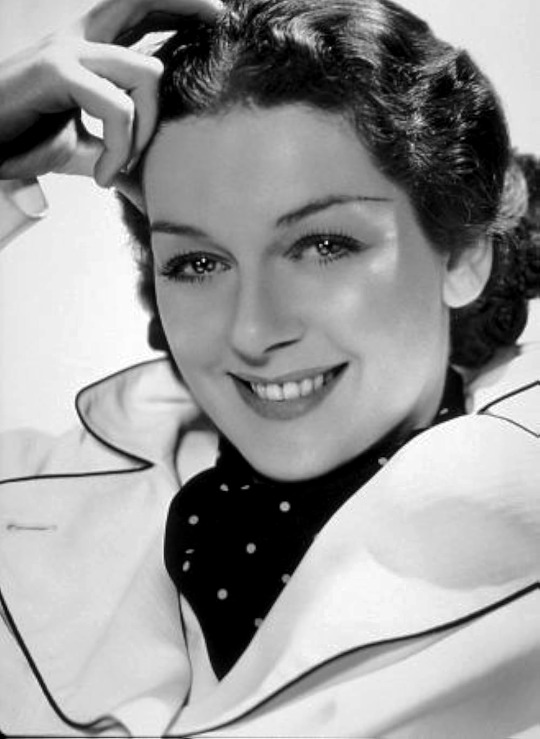

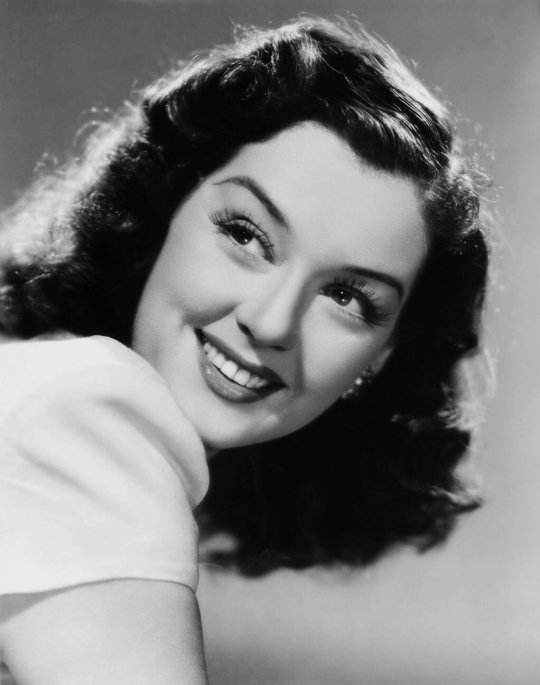


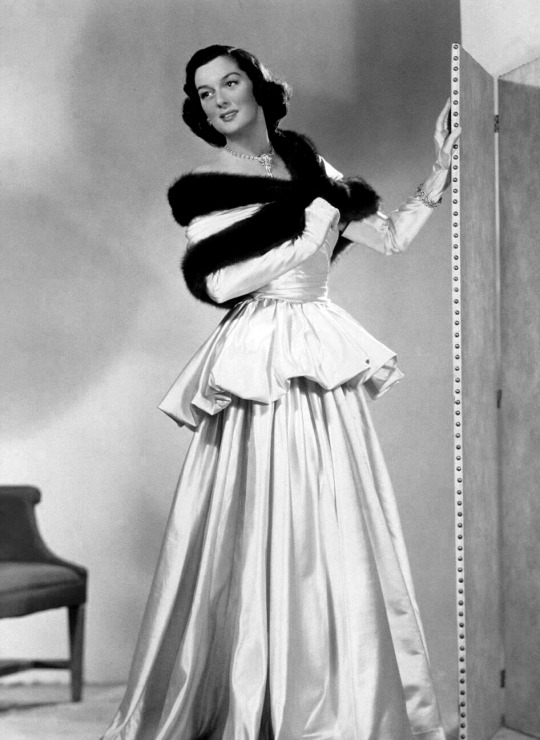

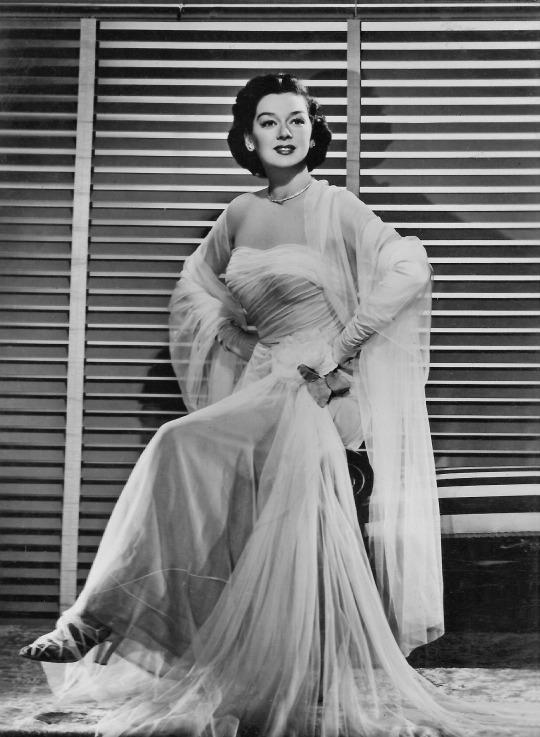




Catherine Rosalind Russell (born in Waterbury, Connecticut on June 4, 1907 – November 28, 1976) was an American actress known for playing sassy, wisecracking women in 1930s and '40s comedies. Despite going through postpartum depression, the deaths of her siblings, breast cancer, and rheumatoid arthritis, she thrived as a charismatic actress on film and the stage, earning the nickname "The Miracle Woman.”
Raised in a strict Irish-American, Catholic family. She attended Rosemont College and Marymount College, before graduating from the American Academy of Dramatic Arts in New York City, unbeknownst to her parents who believed she was studying to be a speech teacher.
Against parental objections, she began her career as a fashion model and took acting jobs in upstate New York, Connecticut, and Boston before eventually appearing in Broadway.
In 1933, Russell went to Los Angeles, where she was hired as a contract player for Universal Studios but did not appear in a movie. Unhappy at Universal, she moved to Metro-Goldwyn-Mayer, where she broke through in the classic screwball comedy His Girl Friday (1940), directed by Howard Hawks.
She took a break after giving birth from her career, but made a comeback with RKO Pictures and then with Columbia Pictures. She continued to appear in critically acclaimed movies and Broadway shows through the mid-1960s, including the title role of the long-running stage comedy Auntie Mame (based on a Patrick Dennis novel) as well as the 1958 film version.
After years of battling breast cancer and even getting a double mastectomy, she died at her home in Beverly Hills, California at 69 years of age. Months after her death, she was honored by her acting colleagues with the “Interlude With Rosalind Russell” at the Shubert Theater in Broadway.
Legacy:
Nominated four times for the Academy Award for Best Actress for her performances in My Sister Eileen (1942), Sister Kenny (1946), Mourning Becomes Electra (1947), and Auntie Mame (1958)
Won all five of her Golden Globe Award for Best Actress nominations: Sister Kenny (1946), Mourning Becomes Electra (1947), Auntie Mame (1958), A Majority of One (1961), and Gypsy (1962)
Won the 1953 Tony Award for Best Actress in a Musical for Wonderful Town and was nominated for the 1957 for Best Actress in a Play for Auntie Mame
Nominated for the 1959 BAFTA Award for Best Foreign Actress
Won the Golden Apple Award in 1942 for Most Cooperative Actress
Awarded the Look Magazine Award for Film Achievement Award in 1947
Covered Time magazine in 1953
Was the namesake of the Rosalind Russell State Theater in her hometown in 1955
Wrote the story for the film The Unguarded Moment (1956) and adapted the novel, The Unexpected Mrs. Pollifax, into the screenplay for Mrs. Pollifax-Spy in 1971, under the pen name C.A. McKnight
Won the Laurel Awards for Top Female Comedy Performance for Auntie Mame (1958) and was nominated for five more
Presented with a medallion by the National Conference of Christians and Jews in 1962
Honored for her distinguished service by the UCLA in 1964
Named the Woman of the Year by Hasty Pudding Theatricals, a student society at Harvard University, in 1964
Is the recipient of the Floyd B. Odlum Award by the Arthritis Foundation in 1971
Appointed by Congress to serve on the National Commission on Arthritis and Related Musculoskeletal Diseases during the 1970s
Received the Golden Plate Award of the American Academy of Achievement in 1972
Awarded the Jean Hersholt Humanitarian Award in 1973 by the Academy for her extensive charity work
Presented her with the National Artist Award in 1974 by the American National Theater and Academy
Awarded the Life Achievement Award in 1975 by the Screen Actors Guild Awards
Hosted by First Lady Betty Ford at the White House in 1976
Honored with the Rosalind Russell Week in 1977 by Los Angeles Mayor Tom Bradley
Co-authored her autobiography, Life Is a Banquet, in 1977
Is the namesake of the Rosalind Russell Medical Research Center for Arthritis at the University of California, San Francisco, created by a Congress grant in 1979
Inducted into the Connecticut Women's Hall of Fame in 2005
Ranked #28 on Premiere magazine's 100 Greatest Performances of All Time in 2006 for His Girl Friday (1940)
Honored as Turner Classic Movies Star of the Month for July 2008
Inducted in the Online Film and Television Association Film Hall of Fame in 2014
Was the subject of a 2016 exhibit at the Mattatuck Museum in her hometown
Honored by the Berlin Film Festival‘s 27-movie tribute in 2022
Has a star on the Hollywood Walk of Fame in the 1700 block of Vine Street for her contributions to the motion pictures

#Rosalind Russell#The Miracle Woman#Roz Russell#Auntie Mame#Silent Films#Silent Movies#Silent Era#Silent Film Stars#Golden Age of Hollywood#Classic Hollywood#Film Classics#Classic Films#Old Hollywood#Vintage Hollywood#Hollywood#Movie Star#Hollywood Walk of Fame#Walk of Fame#Movie Legends#Actress#hollywood actresses#hollywood icons#hollywood legend#movie stars#1900s
1 note
·
View note
Audio
(Literary License Podcast)
Mrs. Frisby and the Rats of NIMH is a 1971 children's science fiction/fantasy book by Robert C. O'Brien, with illustrations by Zena Bernstein. The novel was published by the New York City publishing house Atheneum Books.
This book was the winner of numerous awards including the 1972 Newbery Medal. Ten years following its publication, the story was adapted for film as The Secret of NIMH (1982).
The novel centres around a colony of escaped lab rats–the rats of NIMH–who live in a technologically sophisticated and literate society mimicking that of humans. They come to the aid of Mrs. Frisby, a widowed field mouse who seeks to protect her children and home from destruction by a farmer’s plow.
The rats of NIMH were inspired by the research of John B. Calhoun on mouse and rat population dynamics at the National Institute of Mental Health from the 1940s to the 1960s.
After O’Brien’s death in 1973, his daughter Jane Leslie Conly wrote two sequels to Mrs. Frisby and the Rats of NIMH.
The Secret of NIMH is a 1982 American animated fantasy adventure film directed by Don Bluth in his directorial debut and based on Robert C. O'Brien's 1971 children's novel, Mrs. Frisby and the Rats of NIMH. The film features the voices of Elizabeth Hartman, Peter Strauss, Arthur Malet, Dom DeLuise, John Carradine, Derek Jacobi, Hermione Baddeley, and Paul Shenar. It was produced by Bluth's production company Don Bluth Productions in association with Aurora Productions.
The Secret of NIMH was released in the United States on July 2, 1982, by MGM/UA Entertainment Co. under the United Artists label. It was praised by critics for its elegant and painstakingly detailed animation, compelling characters, and deep and mature plot, and won a Saturn Award for Best Animated Film of 1982. Though only a moderate success at the box office, it turned a solid profit through home video and overseas releases. It was followed in 1998 by a direct-to-video sequel, The Secret of NIMH 2: Timmy to the Rescue, which was made without Bluth's involvement or input and met with poor reception. In 2015, a live-action/computer-animated remake was reported to be in the works. A television series adaptation is also in development by the Fox Corporation.
Opening Credits; Introduction (1.21); Background History (4.50); Mrs Frisby and the Rats of NIMH Plot Synopsis (6.15); Book Thoughts (11.37); Let's Rate (42.18); Introducing a Film (44.01); Secret of NIMH (1982) Film Trailer (46.00); Lights, Camera, Action (48.33); How Many Stars (1:33.30); End Credits (1.35.41); Closing Credits (1:37.18)
Opening Credits– Epidemic Sound – Copyright . All rights reserved
Closing Credits: Flying Dreams (from The Secret of NIMH) by Kenny Loggins featuring Olivia Newton-John. Taken from the album More Songs from Pooh’s Corner. Copyright 2000 Sony Records.
Original Music copyrighted 2020 Dan Hughes Music and the Literary License Podcast.
All rights reserved. Used by Kind Permission.
All songs available through Amazon Music.
1 note
·
View note
Text

POEM THAT DESCRIBE THE PHILIPPINE LITERATURE DURING ACTIVISM PERIOD
There is a connection between
the background of our young Filipinos.
The youth felt compelled to seek reforms as a result of social issues.
Some still held to the view that the democratic government is stable and that the only culprits are those in charge.
Some people thought democracy should be replaced with socialism or communism.
In order to overthrow the democratic form of government, some armed groups were created.
Rizal, Lapu-lapu, and Lakandula.
During the period of activism
The boy started acting out.
The student newspaper displayed disobedient feelings.
MAKIBAKA (TO DARE) is written on signs in red.
Beginning to be released was the bomba film, which criticized Filipino culture.
Youth becamo immoral.
Martial Law was declared in 1972 as a result.
an uprising against the dominant forces
Monopoly of the youth with the blood-fire coursing through their veins
The youth, according to Rizal, are the Fatherland's best hope.
Pineda claimed that around this period, the young people,
Show that our nationality and racial identity are not shaped by perpetual deflection.
Youth proved something true.
The patience of a person has a limit.
If overworked, it can erupt like a volcano.
Aristocratic authors become socially conscious
Writing during the Activism era
Indifference to the impoverished peaked during this age of widespread revolution.
In the years 1970–1972, domestic and international issues led to youth activism.
They fought against the problems in politics and society.
Any business became a representation of the problems that needed to be fixed.
The events that culminated in Ferdinand Marcos' proclamation of martial law in 1972 were significantly influenced by student movement in the Philippines between 1965 and 1972.
The People Power Revolution of 1986 led to the eventual overthrow of the Marcos administration.
Protests and demonstrations
Orginates from the action verb.
Photo source:
https://group4lit1webpage.wordpress.com/period-of-activism-and-the-new-society/
0 notes
Text
Movie Review | Super Fly (Parks, 1972)

Two of my other favourite blaxploitation movies, Black Caesar and The Mack, pose a certain challenge to the audience. Their heroes are so cool, so charismatic, that it's a shock when the movie confronts you with their capacity for cruelty. What does it say about us as viewers that we're rooting for them? There's a certain queasy fascination at the centre of these pictures that makes them all the more thrilling. Gordon Parks, Jr.'s Super Fly doesn't quite confront us in the same way. Certainly Ron O'Neal is no slouch in the cool and charismatic department, but what's really shocking here is the movie's ambivalence to his profession as a drug dealer. He wants to get out of the business not because drugs are harming the community, but because it's wearing him out to play this part in the system. Indeed, the central tension here is between the glamourous lifestyle that drug dealing affords him and the agency it robs of him, and the movie is upfront about the limited opportunities black men have to get ahead in America. The film's most famous sequence, a still photograph montage by the director's father Gordon Parks, Sr. (the legendary photographer who had helmed Shaft the previous year), pushes this dynamic most succinctly, framing the hero's activities as part of a supply chain that reaches across all of society.
With blaxploitation, there's a certain tension between onscreen representation and negative stereotypes when it comes to black characters. Super Fly was not free from criticism (even from its own star, who took issue in particular with the cocaine montage) and almost seems to invite it, with almost all of its characters being mired in this criminal ecosystem. (I will add that the movie was also notable for representation behind the camera, having been made with a mostly non-white crew.) But it's also notable for the way it reorients our perspective from the racial dynamics of mainstream American cinema. The black characters here are our points of identification, our "default", so to speak, the ones we see as well fleshed out human beings and complex interpersonal dynamics (in one scene, we see the hero approached by members of the Nation of Islam, who attack him with a slur that in prior scenes he'd used as a term of affection), while the white characters are the ones who are othered (the hero's white girlfriend is the obvious status symbol, the cops are immediately suspect). The movie's goal is not what I think can be glibly termed as "reverse racism", but rather to bring us into the world of its hero and help us understand the context in which his actions might make sense, even if they're not ones we'd agree with in the real world. A lesser movie would lecture us on why dealing drugs is bad. This one invites us to consider why one would take it up.
The "one last job" plot has been done to death in crime movies, but in 1972 this was perhaps not the cliche it's since become, and the movie's lack of apology for the hero's motivations gives it an undeniable charge. Of course, it helps when the hero is played by Ron O'Neal, seen here with a luxurious coiffure and in all manner of stylish attire, a look that provides a striking contrast with the gritty surroundings. Has anyone looked as dashing running through the back alleys of Harlem as O'Neal in his turtleneck and black safari suit? On a formal level, this is not the most stylish movie, but it makes up for that with the style offered by its protagonist and the soundtrack. Much of the visual style comes from the camera enrapt as it follows O'Neal navigating his environment, like a shark in a nature documentary. Has ever a movie been so infatuated with its star? And of course, there's the Curtis Mayfield soundtrack, more famous than the movie itself, which offers a level of poetic reflection on the proceedings. It's not exaggerating to call this one of the best soundtracks of all time.
And of course, if like me you've listened to that soundtrack more often than you've watched the movie, you'll know that one of the songs alerts us to the fate of a character named Freddie. Once that character appears onscreen, with a presence that reminds one of a teddy bear and is hilariously ill fitting for the grimness of the proceedings, the countdown starts, so to speak. Parks Jr. repeatedly deploys instrumental sections from that track, most likely because it's a great bit of scoring, but the effect (perhaps unintentionally) is that of taunting the viewer. Each time the song comes on the soundtrack, we ask ourselves nervously, will Freddie finally meet his fate?
3 notes
·
View notes
Text
Isabelle Huppert: The Most Dangerous Actress in European Cinema
Etre actrice, c’est avant tout faire l’apprentissage de sa liberté.
- Isabelle Huppert
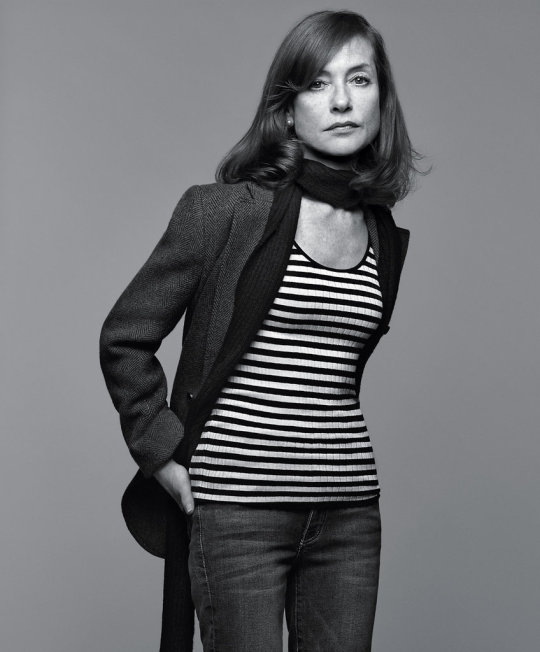
At 66 years old, Isabelle Huppert has had a long, celebrated career and is regarded in the highest echelon of French actors. Among actresses, Isabelle Huppert holds the record for César Award nominations (France’s Oscar award), with a whopping sixteen. She has also had twenty of her films in competition at Cannes, more than any other actress. And she is among just four actresses who have won the Best Actress prize at Cannes twice.
Not a bad track record.
Though she has appeared in a few American productions over the years, including “Heaven’s Gate” (1980), “The Bedroom Window” (1987) and “I Heart Huckabees” (2004), her best films have all been European.
Extraordinary women marked by tragedy and surrounded by mystery — these are Huppert's trademark cinematic roles. The films of Isabelle Huppert tend to be filled with sociopaths, self-mutilators, and murderers.
There was the jealous postmaster in “La Cérémonie,” the gun-toting young bride in “Coup de Torchon,” and the prostitute who poisons her family in “Violette Nozière. “The Piano Teacher,” “Elle” and “Greta” would make a crazy triple feature. Overall Isabelle Huppert, one of the iconic dames of French cinema, has garnered a reputation for being cold and steely. The French actress, now in her mid-60s, consistently chooses roles that are morally complex and sometimes hard to watch. And yet we can’t bring ourselves to look away.

Susan Sontag, who once called Huppert “a total artist,” said she had never met “an actor more intelligent, or a person more intelligent among actors.”
Huppert has been called France’s Meryl Streep for her technical skill, but for all her shape-shifting, Streep’s strongest women have never gone so dark as the roles Huppert has played.
Huppert expresses the moods and mental state of her characters with precision and great sensitivity. Her seemingly expressionless face and sparing facial expressions have become something of a trademark.
Fiction has a tendency to inflate things, she said once in an interview with The Financial Times in July 2017. "But when I look at people on the street, I find that most of them are pretty empty in their eyes. I have to do even less." To observe, she has been taught, you have to take away, not add something.
Isabelle was the youngest of five children, born in Paris to an engineer father and a mother who taught English. Her mother is credited with spotting her talent early on, and encouraging her to develop it. She was already well on her way as a teenager, getting acting jobs while studying at the National Conservatory of Dramatic Art in Paris.
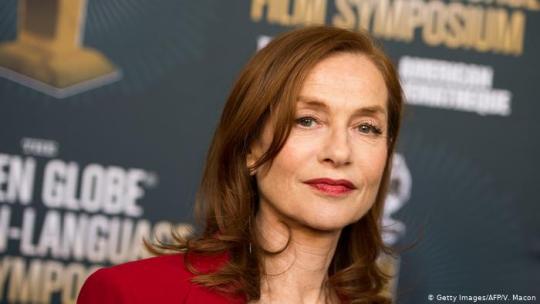
Huppert’s résumé is remarkable over five decades: Just over 140 films since her debut in 1972, for many of cinema’s most audacious visionaries, including Claude Chabrol, Claire Denis, Curtis Hanson, Hal Hartley and François Ozon.
In “Things to Come,” a wistful, funny drama by the French director Mia Hansen-Love. She plays Nathalie, a Parisian philosophy teacher whose husband leaves her for a younger woman, whose mother dies, whose publisher won’t reissue her book — and yet, who finds unexpected freedom in all of these losses. Nathalie heads toward the light and Michèle toward the dark, but both roles showcase Huppert’s great ability to derive power from vulnerability.
What directors loved about Huppert — and she prides herself on being an auteur’s actor — was her ability to convey moral complexity in the most unique ways.
Working with such auteur directors, Huppert can inhabit extreme characters — "survivors who can be victims and rebels simultaneously," says the actress. "My films give these women a voice. Because even though they live on the edges of society, they are there: women who live brutal lives. It's a brutality that they themselves never sought out," Huppert told Zeit Magazine.
Paul Verhoeven who directed her in “Elle” described Huppert as a “pure Brechtian actor,” in that she puts distance between herself and the audience, without trying to seduce it or seek its sympathy.
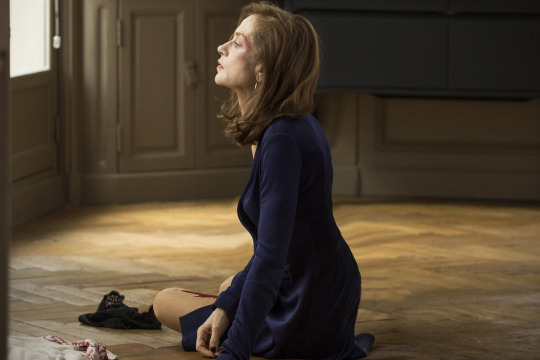
The actress is notorious for her illegibility - her almost Bressonian lack of expression, and the profound unrest she’s able to convey from behind the stillness of her freckled resting face. Pauline Kael, the famous film critic, once complained that “when [Huppert] has an orgasm, it barely ruffles her blank surface.” If Kael had lived to see “Abuse of Weakness,” “Elle,” or “I Heart Huckabees,” perhaps she would have come to appreciate how the stillness of Huppert’s unbeatable poker face allows her to normalize even the strangest and most perverse of characters; to make it seem as though any of their behaviors, no matter how unusual or demented, are as natural to them as we are to ourselves.
It’s a quality that European directors and audiences have embraced, but which can seem more foreign to Americans. Huppert loves American cinema, but she also knows her sensibility is distinctly French.
Huppert is known for her privacy and reserve - she generally doesn’t talk to the press about anything other than her films - and if there’s a connection between her autobiography and the roles she chooses, that’s something that only she knows.

Aware of her own enigmatic appeal, she has no qualms about exploiting it. She has even less desire to charm, although her formidable impassivity sometimes betrays a hint of vulnerability. Not that she will let the viewer get too close, however, as she is forever intent on remaining “more like a question mark than a statement”.
Isabelle Huppert is not just courageous when it comes to choosing film roles and artistic collaborators. She is fearless, and such is her integrity that we trust her instincts and follow wherever she leads. That’s what makes her the most dangerous actress of our time.
Below is a top ten list of Isabelle Huppert films. They are not in order nor are they her very best. There are simply too many films in her body of work that would deserve equal consideration. Instead the list is made up of films that given an introduction to her wide ranging talents.

1. The Lace Maker 1977
Isabelle Huppert won the most promising newcomer award for her graceful, guileless performance as Pomme in Claude Goretta’s masterly adaptation of a Pascal Lainé novel, which took its title from a Vermeer painting. Whether doing her chores at a Parisian beauty salon, playing blindman’s buff on a Cabourg clifftop with dashing Sorbonne student Yves Beneyton, trying to eat an apple without disturbing his reading or choking over dinner with his snooty parents, Huppert is mesmerising.
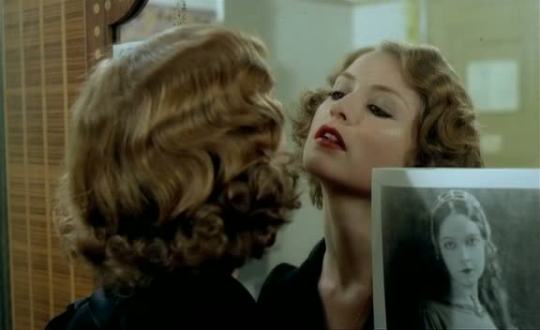
2. Violette Nozière 1978
The first of her seven collaborations with Claude Chabrol earned Huppert the best actress prize at Cannes. She was 25 when she played the demure schoolgirl who shocked 1930s Paris when details of her double life as a prostitute emerged following the poisoning of her father. Violette claimed he had abused her, but Chabrol thinks otherwise and exploits Huppert’s genius for switching between fragility and cruelty to counter the surrealist myth that the teenage parricide was an anti-bourgeois icon.
Huppert embodies this character that’s chiefly concerned with finding love. She walks the streets at night, characteristically promiscuous, but don’t call her a prostitute. She’d refute. Throughout the film, she gives more money to the men then vice versa. At night, when she leaves her quiet bourgeois home, and finds a man to accompany her, she looks unusually bothered. The film is sometimes maddeningly ambiguous but perhaps that’s the point - Chabrol and Huppert want us to feel mixed about her.
Violette is a woman with an air of mystery around her. She’s precocious but not as clever as she thinks. Huppert gazes and kisses her own mirror reflection. She writes fictional love letters to herself as well. Huppert quietly stresses the motivation behind the character: desperate to find someone to love, or else she’ll have to love herself. Except, she can’t even love herself because she feels stifled by her home life. And as ever with narcissism, there are dangerous consequences.
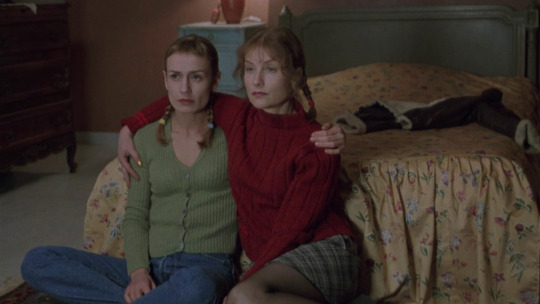
3. La Cérémonie 1995
“Chabrol only ever cast me as fairly ordinary characters,” Huppert once revealed. “They just have rather particular destinies.” While she would go on to embody Chabrolian womanhood (“not victims, not fighters, somewhere in between”) in Rien ne va plus (1997), Merci pour le chocolat (2000) and Comedy of Power (2006), she gave her finest performance for him in this seething adaptation of Ruth Rendell’s A Judgement in Stone.
An upper-class family warns their meek maid (Sandrine Bonnaire) about the local mail lady, Jeanne (Isabelle Huppert). They become friends regardless. Huppert plays Jeanne as kooky, comic, and rebellious. We gradually find out more cryptic background on her character, which gives her spirited attitude a darker edge. She’s either heartbroken or heartless. Huppert portrays a character with so many contradictory traits without ever making it feel false.
Huppert performs the role cunningly. Jeanne is energised like a child, but she’s smart enough to know how to win over the maid. She’s a little silly - when she enters the family’s home while they’re away, she touches everything. Huppert balances all of this next to the near-mute Bonnaire, both slowly exacting their revenge against the upper class. Chabrol’s trademark: clash of the classes.
Huppert thoroughly deserved her first César.
In 2014, Huppert performed Jean Genet’s play The Maids with Cate Blanchett. The play was inspired, as was La Cérémonie, on the same true-story about the Papin sisters.
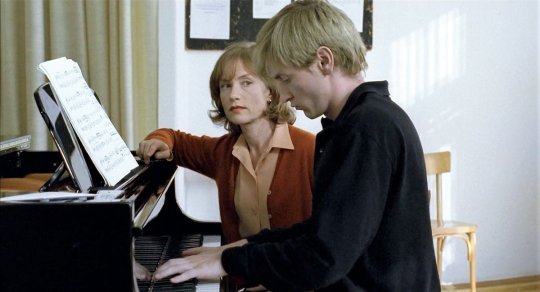
4. The Piano Teacher 2001
The Piano Teacher is an elegantly made film about the deranged endeavors of love. Huppert plays a buttoned-up music instructor, Erika, who attracts the eyes of an unassuming man half her age. She still lives with her mother and there’s a danger that lurks behind her carefully placed gaze. She’s been sexually repressed for such a long time; her repression and self-hatred has slowly evolved into masochism. It drives her to haunt peep shows, spy on copulating couples and mutilate her own genitals. This disturbing film really made an impact world wide.
Nobody said this film was an easy watch!
Haneke gives the spectator all the intricacies of the concept of perversion inserted in Huppert’s character of Erika, a successful piano teacher and an apparently impeccable social life. Well, that’s what Erika keeps on the surface.
Huppert declared the second of her four collaborations with Haneke to be the film she had long been searching for.

5. 8 Women 2002
There’s no validity in the truism that Huppert doesn’t do comedy. In fact she proved she could both dance and sing (the plaintive ‘Message personnel’ is a career highlight) in François Ozon’s chic 1950s musical whodunit. Sporting a tight bun, a buttoned-up twin-set, pursed red lips and butterfly spectacles, Huppert invokes the spirit of legendary farceur Louis de Funès as Catherine Deneuve’s argumentative sister. She gives an indelible display of neurotic, spinsterly bitchiness that is simultaneously piteous and hilarious.
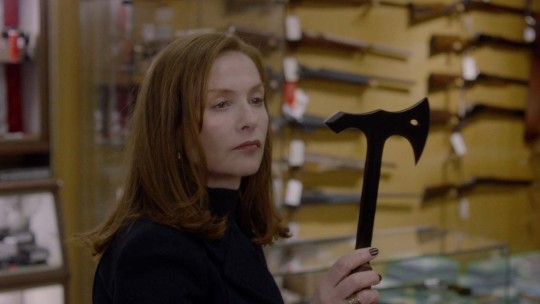
6. Elle 2016
A successful woman enters a real ordeal after being raped by a stranger in her home. Powerful, ‘Elle’ unravels all the nuances of a character’s life inserted into a completely incongruous personal, social and psychological reality. Here, the character will demonstrate how her attitude towards the world follows a sociopathic pattern of acting, despising any form of emotional attachment and using other individuals solely to satisfy her most primitive instincts. The film earned her an Oscar nod for Best Actress, which was fabulous but also made me wonder what took so long. Certainly she’s turned out enough superb performances over her nearly five decade career to have earned this recognition sooner.

7. Coup de Torchon 1981
Having survived a seven-month stint in Montana for Michael Cimino’s Heaven’s Gate(1980), Huppert ventured to Saint-Louis in Senegal for Bertrand Tavernier’s Oscar-nominated transposition of Jim Thompson’s pulp novel, Pop. 1280, from a small Texan town in the 1910s to west Africa on the eve of the Second World War. Although Pierre-William Glenn’s sun-scorched Steadicam imagery seems antithetical, this is a darkly droll noir that sees Huppert in an unusually skittish mood, as the abused colonial wife who forges an unlikely alliance with Philippe Noiret’s pathetic rogue police chief, who is humiliated by everyone around him, and suddenly wants a clean slate in life - but resorts to drastic means to do so.
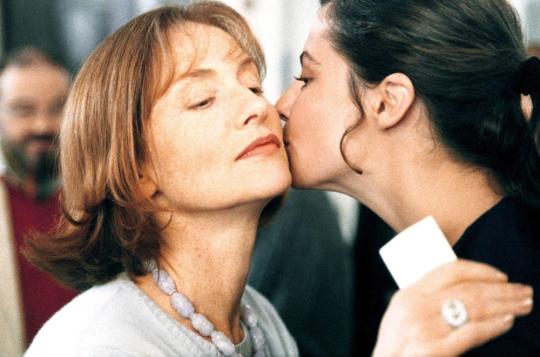
8. Merci pour le chocolat 2000
The film follows the nuances of a French upper class family, exploring the destructive ways in which each member acts on the world. Directed by Claude Chabrol, ‘Merci pour le Chocolat’ is an interesting film, bringing a more cadenced plot that values studying each meander of the behavior of its central characters.
The movie is set in Lausanne, and that Swiss location, having an ambient sense of buttoned-up severity and menace, is an appropriate setting with a Nabokovian mien for this horrid tale of sociopathy.
Huppert dominates the film with the slightly frigid poise of a great dancer who has retired to become an exacting teacher. She plays Mika, a woman who presides wearily and almost negligently over the prosperous chocolate business built up by her late father. But however disengaged she is in the boardroom, in the kitchen she loves chocolate with a passion - concocting various types of drinking chocolate, using subtly differing recipes, with fanatical and murderous care.
There is something fascinating about Huppert's face here. In repose, it has a kind of unsettling serenity, the serenity of a cunning and covert predator who has already decided on an unspeakable course of action.
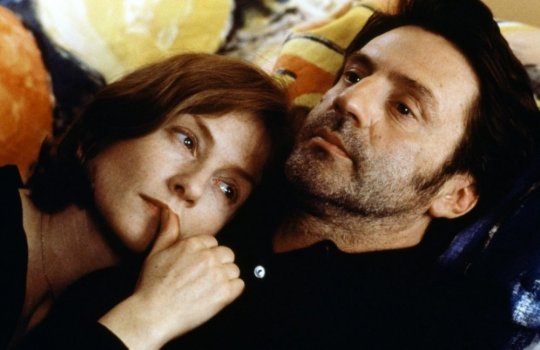
9. La Séparation 1994
Isabelle Huppert and Daniel Auteuil play a couple on the verge of a separation. The relationship’s mainstay is their child, one-year-old Loulou. Autueil gets most of the film’s focus, but he’s essentially a sitting duck, nervously shifting between passive-aggressive contempt and hopeful endearment, as he prepares for the outcome of his girlfriend’s infidelity. He says, “Never two without three.” This could be the quote-totem of the film.
The director smartly leaves the interloping lover out of the film (he’s never seen or even named). Instead, we study Auteuil’s growing impatience and Huppert’s pivotal decision. She adds a lot of depth to a character that could’ve just been the unsympathetic partner of the cuckold.
Huppert gives her character integrity and even though she’s ostensibly guilty, she never comes off as purely selfish. She’s troubled, as well, by their situation - we sense her detachment not due to ego but because she’s boggled in trying to assess the right mode of conduct. Huppert and Auteuil have great chemistry, changing gears effortlessly between vitriol and affection.
Huppert’s distinctive talent for suppressing suffering is readily evident in her slowly disintegrating relationship with Daniel Auteuil, as Huppert imparts chilling intimacy to a withdrawn hand, an unanswering gaze, a treacherous silence and a careless word in conveying the pain of falling out of love.
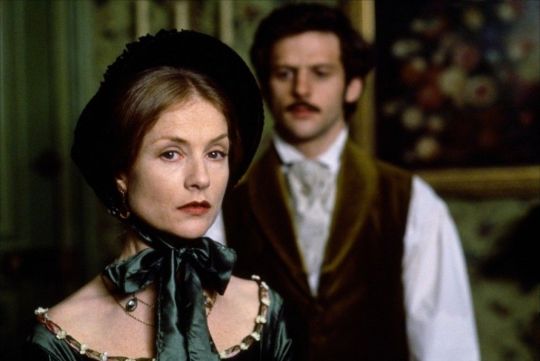
10. Madame Bovary 1991
Not her greatest film but certainly one of the most accessible for anyone not familiar with the talents of Huppert. Based on Gustave Flaubert’s fabulous novel, the film brings the exacerbated trajectory of a young girl who has a highly romanticised view of the world and craves beauty, wealth, passion, as well as high society. It is the disparity between these romantic ideals and the realities of her country life that drive most of the novel, leading her into two affairs and to accrue an insurmountable amount of debt that eventually leads to her suicide.
This adaptation of ‘Madame Bovary’ is perhaps the best of any adaptation to date. Claude Chabrol manages to capture even the most emblematic nuances of Flaubert’s book, elevating a unique atmosphere for the unfolding of scenes.
However, the main point of distinction between this work and the others is the presence of Isabelle Huppert as protagonist, delivering a powerful and visceral performance from the first to the last scene.
#isabelle huppert#film#cinema#french#france#culture#art#actress#acting#artist#icon#femme#huppert#french cinema
152 notes
·
View notes
Text
Maya Angelou
Let me tell you one of the most soulful people I've learned about, Maya Angelou. She's an absolute queen with so much perseverance and wisdom. I don't think I've learned about someone with so many quirks in numerous areas from writing to dancing, to directing, to singing; she's amazing so please give this a read.
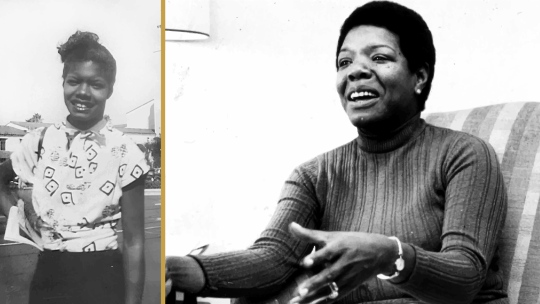
First, who is Maya Angelou? A brief preview.
An African-American author, a poet, a singer, an activist, a scholar, a scriptwriter, an actress, and a dancer
Best known for her unique and pioneering autobiographical style
Born on April 4th, 1928 and died on May 28th, 2014
She was born in St. Louis, Missouri
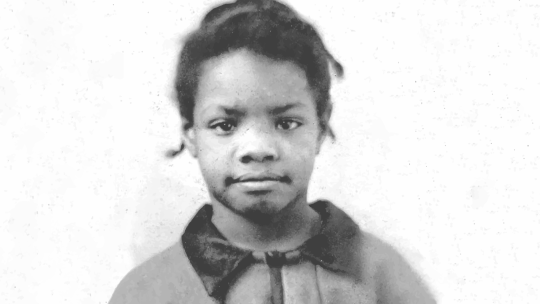
Maya's Traumatic Early Life
At an early age, Maya was sent to live at her grandmother’s place in Stamps, Arkansas because of her parents tumultuous marriage and eventual divorce
It was her older brother, Bailey, who gave her the nickname “Maya”
Living with her grandmother helped her develop pride and self-confidence
When she returned to her mother’s care briefly at the age of 7, she was raped by her mother’s boyfriend
When he was jailed and released not a day later, he was killed
Traumatized by his death, she later said, “I thought my voice killed him; I killed that man because I told his name. And then I thought I would never speak again because my voice would kill anyone …”
She became mute for 5 years, her usual lustrous personality crushed
She returned to live with her grandma through her teens and during the times she was mute, she holed herself in libraries, memorizing all books line by line like Shakespeare’s plays and sonnets, and Poe’s poetry; thought to be the beginning to her love for literature and writing
Her Literary Career/Famous Works
“I Know Why the Caged Bird Sings” (1969)
Her most critically acclaimed book, spanning her childhood as she and her brother bounced back and forth from her mother's place to her grandmother's
She wrote this during her time with the Harlem Writers Guild, a safe community that supported African writers, in NYC
It narrated her experiences with racism, molestation, rape, and her chronic displacement

“Gather Together In My Name” (1974)
follows after "I Know Why The Caged Bird Sings" when Angelou was 17-19 years old
the book depicts a single mother's slide down the social ladder into poverty and crime
the title was from the Bible but it also conveyed how a Black female lived in the white dominated society of the US after WWII
its themes were motherhood and family, racism and identity, education and literacy
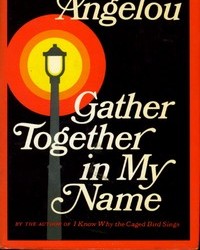
“Just Give Me a Cool Drink of Water ‘fore I Diiie” (1971)
Angelou's first collection of poetry
many of the poems were song lyrics, inspired at Angelou's time in her life when she was nightclub singer in her 20s
it was nominated for a Pulitzer Prize in 1972

“Mom & Me & Mom” (2013)
her final book and 7 book memoir series that focused on her relationship with her mother
it covered her budding relationship with her mother when she was young with themes of reconciliation and reunion

Interesting Trivia
She was the first Black female street car conductor when she persisted for work at San Francisco in high school; “I loved the uniforms”, she had explained.
She was a civil activist, advocating for African-American rights as the northern coordinator of the Southern Christian Leadership Conference
After working as a dancer a club in San Diego, she had a short lived personal sex history but quit after she bought her first car, a 1939 pale-green Chrysler convertible
In 1972, she was the first African American to have her screenplay turned into a film, “Georgia, Georgia”; she’s also had a wide variety of singing, dancing, acting, and directing and producing shows and movies
She was besties with Martin Luther King Jr. and after his death, she sent flowers to his wife for more than 30 years until her death
She’s also very close friends with Oprah Winfrey, appearing on her show twice, and giving her life-changing advice during her hardships
Reflection
I had the chance to read Angelou's final book "Mom & Me & Mom" and I think it really showed a lot of how Angelou was the person she was today. Her mother, like her, was a very strong willed woman who had taught her how to be independent, to be courageous, and proud in such oppressive society. They were like two peas in a pod, two women who came together with their stories of experience, and teaching one another how to love themselves, to be empowered, and courageous. I related to the story with my own close relationship with my mother. Like Angelou and her mother, my mother and I were like a student and mentor and best friends all while still being parent and daughter. It made me appreciate and love my mother, and really keep the things she taught me close to my heart. This book was so monumentally relatable, I had to order my own copy to annotate it with my own experiences.
Angelou was a woman who wanted others to be strong, to be courageous, to love themselves, and see their misery and hard times as new opportunities that would being them happiness. Her personality was bright even when she was quite old, and she was so animated and influential, it's hard to be distracted if you watch her interviews. Like many female authors, Angelou's experiences have impacted the way she wrote her books; but her soulful autobiographical style makes her books unique; it doesn't seem like it's about the author, but a character who the reader can relate to and follow along her joys and miseries.
Thank you for reading this far and please give Maya Angelou's books a read. She has wisdom that society needs during these times of turmoil.
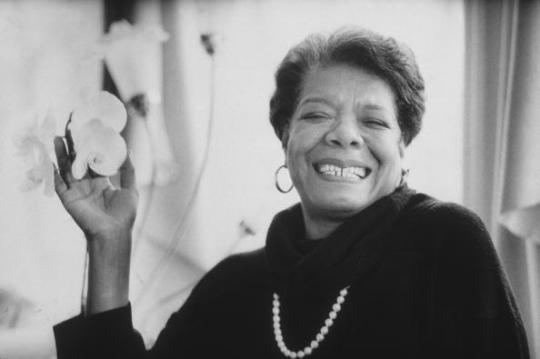
References:
A. Spring, Kelley. “Maya Angelou.” National Women’s History Museum, 2017, www.womenshistory.org/education-resources/biographies/maya-angelou.
Edmund, Aiyana. “10 Fascinating Facts About Maya Angelou.” Literary Ladies Guide, 22 Feb. 2018, www.literaryladiesguide.com/literary-musings/10-fascinating-facts-maya-angelou.
“Maya Angelou.” Biography, A&E Television Networks, www.biography.com/writer/maya-angelou.
Gibson, Megan. “A Guide to Maya Angelou’s Most Beloved Books.” Time, TIME USA, LLC, 28 May 2014, time.com/123030/maya-angelou-best-books.
“Maya Angelou Biography - Life, Children, Parents, Name, Story, Death, School, Mother, Young.” Encyclopedia of World Biography, Advameg, Inc, www.notablebiographies.com/An-Ba/Angelou-Maya.html.
3 notes
·
View notes
Text
THE ORDER OF NATIONAL ARTIST FOR THEATER
1. DAISY HONTIVEROS AVELLANA

Daisy Avellana, a pioneering actress, director and writer whose career spanned the emergence and flowering of modern Philippine theater, and whose seminal contributions to the field led to her being declared a National Artist for Theater in 1999. Born in Roxas City, Capiz, on Jan. 26, 1917, Avellana became one-half of a celebrated husband-and-wife team of Olympian Filipino artists—the other half being film and theater director Lamberto Avellana, who was conferred National Artist honors in 1976. They were the Oliviers of their day, producing and writing material for all available media, from stage to radio and film.
2. ROLANDO S. TINIO

Rolando S. Tinio National Artist for Theater and Literature (1997) (March 5, 1937 – July 7, 1997) Rolando S. Tinio, playwright, thespian, poet, teacher, critic, and translator marked his career with prolific artistic productions. Tinio’s chief distinction is as a stage director whose original insights into the scripts he handled brought forth productions notable for their visual impact and intellectual cogency. He is better known as a playwright and translator of plays, founding and artistically directing the Teatro Pilipino (1975-92). The plays he translated into Tagalog range from Sophocles and Shakespeare to Chekhov and Beckett. He worked as a set designer as well as director, had a career as an actor for film and television, wrote film scripts and teleplays. His first book of poems in Tagalog, Sitsit sa Kuliglig (Cricket Gossip), was published in 1972; there were two others and in 1994, a selection of his poems in English and Tagalog. These books don’t include the lyrics to numerous songs. He died in 1997. Among the most popular of his poems are a handful of poems not wholly in Tagalog, but in a code-switching combination of Tagalog and English.
3. WILFRIDO MA. GUERRERO

Wilfrido Ma. Guerrero is widely recognized in the field of theater and literature. As a playwright having written over 40 plays in his lifetime including Wanted: A Chaperon, The Forsaken House, Three Rats, Half an Hour in a Convent and more, it is not a surprise that educational institutions would integrate his works in learning structures and generate discourses regarding the themes present in his works and their socio-political significance. His works often portray subject matters well-known and well-received by Filipinos; reinstating social conditions, realities and disparities of his contemporary whilst utilizing humor and wit in his dialogues. From being able to write a full-length play at the age of 14 to working as a scriptwriter for Filipino films, a proofreader and drama critic for news publications (La Vanguardia and Manila Tribune, respectively), Wilfrido Ma. Guerrero’s undoubted skill had lead him to render his talent in teaching and devoting 35 years of his life as a theater practitioner—ultimately playing an integral part of the revolution in Philippine drama and theater in the 1940s and beyond.
4. SALVADOR F. BERNAL

Salvador F. Bernal Born in 1945 to a family that ran a terno shop, Bernal was exposed to the rudiments of fabric, cut, and silhouette early in life. At the Ateneo de Manila (BS 1966), he honed his talent as a poet and philosopher, acquiring the ability to read a text and imagine its theme as a visual conceit. At the Northwestern University in Evanston, Illinois (MFA 1972), he studied, practiced, and handled courses in the art and craft of theater design. After his return in 1973, Bernal taught briefly at the Ateneo and the University of the Philippines, but soon plunged headlong and full-time into a life of design, which until then was largely unchartered territory. In 2003 and for the first time in the history of the awards, the National Artist Award was given in the field of theater design, and, fittingly, it was presented to Salvador F. Bernal, not because he pioneered theater design in the country, but because he was the first to develop it as a profession and to elevate it to the level of an art form.
5. SEVERINO MONTANO
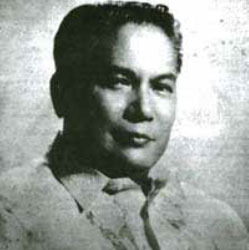
Severino Montano Playwright, director, actor, and theater organizer Severino Montano is the forerunner in institutionalizing “legitimate theater” in the Philippines. Taking up courses and graduate degrees abroad, he honed and shared his expertise with his countrymates. As Dean of Instruction of the Philippine Normal College, Montano organized the Arena Theater to bring drama to the masses. He trained and directed the new generations of dramatists including Rolando S. Tinio, Emmanuel Borlaza, Joonee Gamboa, and Behn Cervantes. He established a graduate program at the Philippine Normal College for the training of playwrights, directors, technicians, actors, and designers. He also established the Arena Theater Playwriting Contest that led to the discovery of Wilfrido Nolledo, Jesus T. Peralta, and Estrella Alfon. Among his awards and recognitions are the Patnubay ng Kalinangan Award from the City of Manila (1968), Presidential Award for Merit in Drama and Theater (1961), and the Rockefeller Foundation Grant to travel to 98 cities abroad (1950, 1952, 1962, and 1963). Severino Montano (1915 in Laoag, Ilocos Norte – 12 December 1980) is considered as one of the Titans of Philippine Theater.[by whom?] He was a playwright, director, actor and theater organizer with an output of one novel, 150 poems and 50 plays in his 65-year lifetime. Through the foundation of the Arena Theater, Montano institutionalized “legitimate theater” in the Philippines, he also have lifetime achievement award as part of National Artist of the Philippines. Academically, Montano started his tutelage under a British mentor, Marie Leslie Prising, when he was thirteen, he studied at the University of the Philippines. She took Montano under her wing and endowed him with Western literature, the theater and Shakespeare, he was part of the UP Stage when he studied in the University of the Philippines. Then a scholarship took him to the famous "English 47" or "Workshop 47" playwriting workshops of George Pierce Baker at Yale University and guided by Broadway names and international personalities like Komissarjevsky of the famous Moscow Art Theater. He was conferred a Master of Fine Arts degree in playwriting and production by Yale University. Montano’s pioneering of the Arena Theater has been one of the many changes in the Filipino arts scene in the 50s. It has brought theater arts as a form of entertainment and celebration of Filipino drama to the far flung barrios of the Philippines. The theater catered to grassroots audience, bringing theatre closer to the hearts of the Filipino masses of his generation. Severino Montano’s large-scale feat for the small people of society. The afterglow of his works continues to light the path of the new generation of artists, poets, and playwrights he further expounded. Severino Montano’s works include:The Love of Leonor Rivera (poetic tragedy in two-parts), My Morning Star (poetic historical tragedy in three-parts), But Not My Sons Any Longer (poetic tragedy in two-parts), Gabriela Silang (poetic historical tragedy in three-parts), The Merry Wives of Manila (comedy of manners in three-parts), Sabina (tragedy), The Ladies and the Senador (satirical comedy) and Parting at Calamba (historical drama).
14 notes
·
View notes
Photo
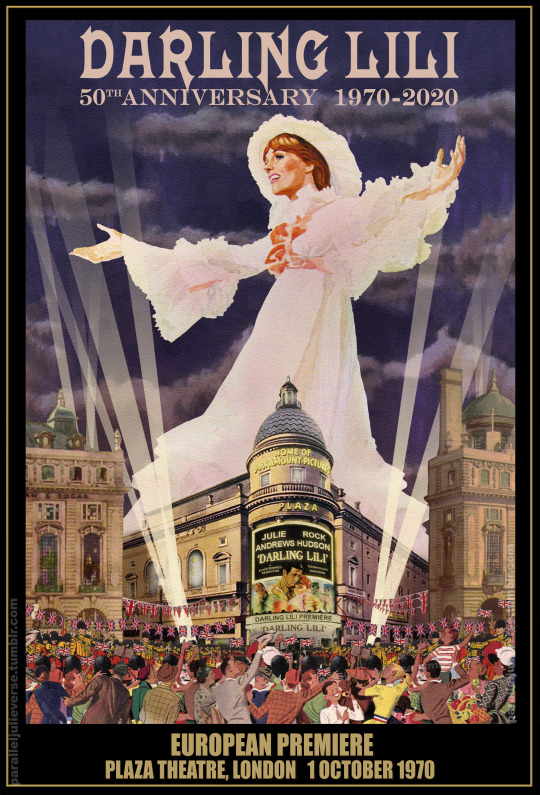
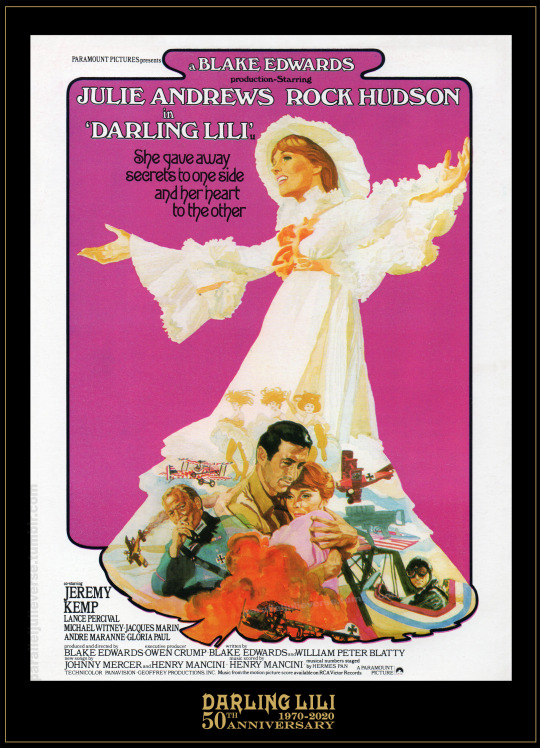

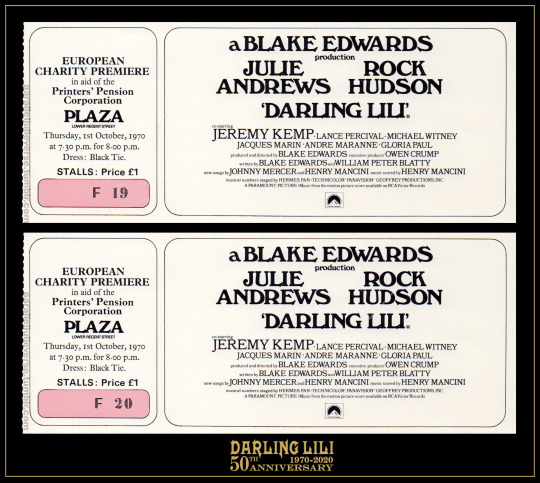
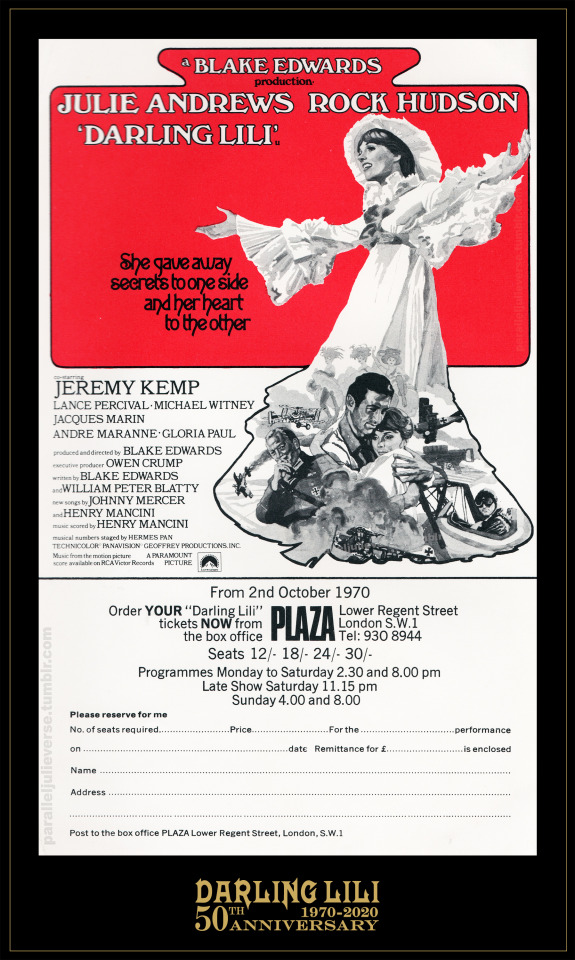



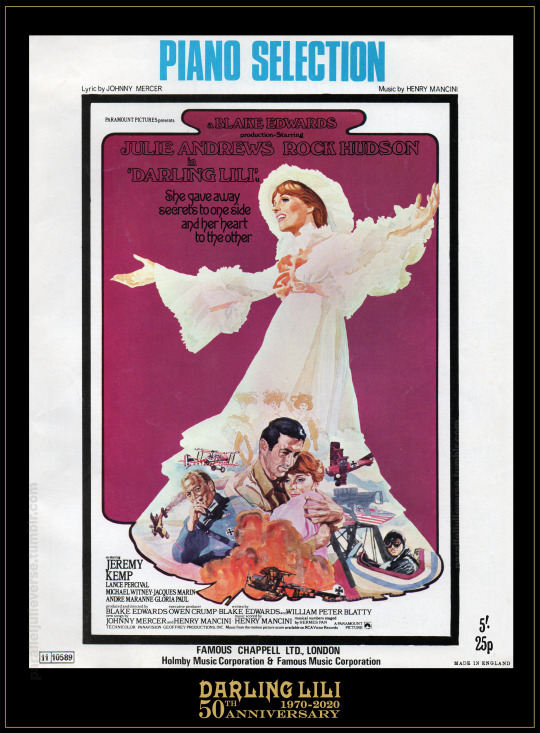
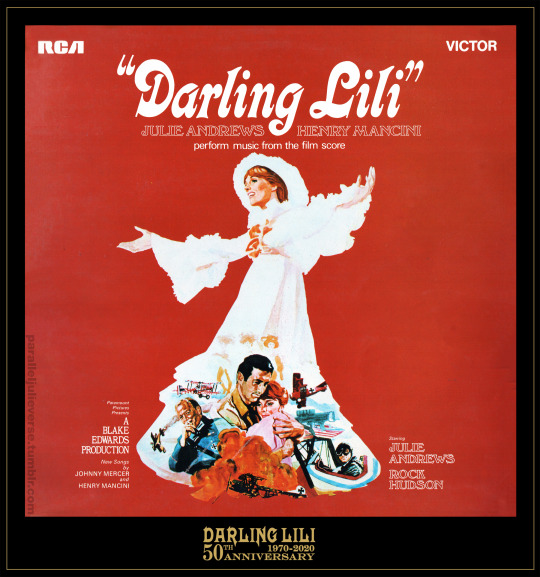
LILI IN LONDON: Darling Lili Makes Her European Bow
Fifty years ago this week, Darling Lili had its official European Premiere at the Plaza Cinema in London on 1 October, 1970. It wasn’t the film’s first international release -- that honour fell to Japan, where Darling Lili opened at the Cinerama Theatre Tokyo on 4 July, barely two weeks after the film’s US opening. However, the London premiere was a significant occasion in the film’s wider global rollout. It was, after all, Julie Andrews’ hometown and there was considerable hope local audiences would give the film a warmer reception than had been the case in North America.
Accordingly, the UK branch of Paramount Pictures afforded Darling Lili a high profile release. They exhibited the film as a full roadshow attraction, complete with widescreen 70mm print, overture and exit music, and a 24-page souvenir programme (Klar 1970). In keeping with the era’s norms of variegated international film marketing, completely new promotional artwork was commissioned for the UK release. Featuring a central image of Julie/Lili bursting into song with her arms outstretched -- a clear nod to The Sound of Music -- with a cloudburst of narrative scenes from the film fanning across the bottom of her billowing skirt, it was an arresting design that served as a ready-made marketing logo for the campaign that could be emblazoned across the full range of advertising and merchandising (Paramount 1970).
The gala premiere took place on Thursday, 1 October -- Julie’s 35th birthday, incidentally — at the Plaza Cinema in Lower Regent Street, just off Piccadilly Circus. Popularly dubbed the “Home of Paramount Pictures”, the Plaza had long been the London venue of choice for the studio’s biggest film premieres (Eyles, 26-28). Though not an official Royal Performance, the European Premiere of Darling Lili was a major society charity event with proceeds going to the Printer’s Pension Corporation, one of the oldest royally-sponsored occupational charities in the UK. Tickets were available from £1 to £5 in the stalls and £10 to £20 in the Circle with the event raising over £6000 for the charity (”Darling Lili Aids”, 12).
Official patrons of the Printer’s Pension Corporation, Lord and Lady Hartwell presided over the evening, welcoming a line of society notables and assorted local celebrities including Sue Lloyd, Judy Geeson, Clodagh Rogers and Julie Ege (“Darling Lili Has”, 32). Neither Julie nor Blake was able to make the premiere, though Julie’s parents were in attendance as honorary guests. Representing the cast, Lance Percival, who plays the comic support role of T.C. Carstairs in the film, “arrived at the Plaza in a vintage white Rolls Royce driven by a female chauffeur” (ibid.). Press reports noted that the “premiere drew large numbers of films fans to the theatre” and “the capacity audience...repeatedly applauded during the presentation of the film” (ibid.)
Following the premiere, Darling Lili opened the next day on 2 October to the general public. In a way that paralleled the experience at New York’s Radio City Music Hall, the decision to stage the film as a special event prestige picture worked well. Lili ran in roadshow release at the Plaza for over three months till 6 January 1971. It then continued to play in general release at various venues throughout London such as the ABC Cinema-Edgeware Rd well into late-1971.
Critical responses to Darling Lili in the London press ran the gamut. The film garnered several positive notices. Patrick Gibbs of the Daily Telegraph rated it “a very amiable and romantic comedy-thriller” (P14). The film “offers many pleasures,” declared the Daily Mail, with “Miss Andrews singing, dancing, delighting...with some very pretty songs...and amusing performances” (Cable, 9). The critic for the Evening Post opined:
“It is fashionable to sneer at Julie Andrews’ films as being sickly-sweet and 20 years out of date--but I can only say I enjoyed this one...Darling Lili is an enjoyable, emotional, light-hearted love story with a strong comedy element” (Watson, 7).
Other reviewers were less enthusiastic. The critic for the Daily Mirror was unsure “what kind of film Darling Lili was supposed to be”:
“Taken as a spy send-up, it’s harmless enough and drags only occasionally, but the comedy doesn’t always blend with the drama. The ending...is a cloyingly sentimental cop-out and a shade nauseating” (Richards, 19).
More than a few UK commentators baulked at the film’s irreverent treatment of World War 1--perhaps unsurprisingly given the enormous significance of the “Great War” to British history and national mythology. The critic for The Tablet, for example, called the film “a monstrous betrayal of the period.” Its “trivialisation of the issues is outrageous...I have no doubt it will be popular, but it shouldn’t be.” Still, he conceded, the film’s “photography...is very pretty and Miss Andrews’s voice is as pure as ever” (Burke, 959).
Critical concessions to “our Julie” were a notable feature of many London reviews. The all-important Times review declared:
“I wish I could like Darling Lili more. I love musicals and remain unrepentantly devoted to Julie Andrews, but this lavish new vehicle for her talents is the most upsetting sort of misfire--the sort which could so easily have been put right, with a little more thought (or a little less worry), a little more confidence in hitting the right tone and sticking to it...a disappointing waste of all the talent and money so evidently lavished on it” (Taylor, 13)
It was a sentiment echoed in The Illustrated London News:
“Miss Andrews sings well, acts decently, and even does a strip number that reveals a new side to her talent as well as a gorgeous, long-concealed, pair of legs. But, alas, not even she can save this ponderous film with its strange blend of old-and-new songs, its heavyweight prankishness, and its inordinate length” (Billington, 31).
Or again the review in The People:
“Julie has charm, grace, plus a good singing voice and Henry Mancini’s music is haunting. But the character she portrays...is hardly endearing. The story...is improbable too, even for a musical. But there are some smashing flying sequences and I like Julie’s style--so I wish it well” (Nunn, 7).
While Darling Lili opened with a splash and did decent enough business in London, it faced very different prospects elsewhere in the UK where the film became something of an inadvertent hostage in an ongoing industrial dispute. At issue was an attempt by US distributors to loosen the stranglehold and perceived old-fashioned exhibition practices of the two big regional UK chains: ABC and Odeon (“Elvin Raps”, 196; “Compromise Ends”, 24). Unable to agree on new terms, the distributors withheld several big features, including Lili, from release to these chains. As a result, Lili’s broader UK rollout was held up for months and, in some cases, years. The film didn’t get a Midlands release, for example, till April 1971 when it opened for a fixed season at the Regal Cinema in Leamington, “an independent theatre whose booking agents were able to come to terms with the distributors” (“Regal Breaks,” 2). The film then popped up intermittently at other independent theatres across the UK: Margate in September, Liverpool in October, and Belfast in January 1972.
Many major provincial markets missed out on the film completely. In a disgruntled letter to the local newspaper in early-1972, one Birmingham fan wondered if “there is a particular antipathy to musicals in our city. We have yet to see Darling Lili (Julie Andrews) and On a Clear Day You Can See Forever (Barbra Streisand), both of which have been shown in London” (Krober, 6). In a similar vein, a Reading filmgoer complained that his local ABC cinema was screening endless reissues while many new films “have yet to play in Reading..that are certainly worth a showing” such as “Julie Andrews and Rock Hudson in Darling Lili” (Suter, 10).
The UK distribution dispute was eventually resolved and Darling Lili managed to make its way out to a broader range of provincial centres including Birmingham, where it opened at the Odeon in April 1973. But by this stage the film was hardly new and whatever marketing impetus was there from the London campaign had well and truly evaporated. It was an unfortunate fizzling out for what could have otherwise been an effective national release for the film. Still, UK filmgoers who missed Darling Lili in theatres didn’t have to wait too long to catch it on the small screen. It made its British television debut as the ‘Film of the Week’ on BBC-1 on 2 April 1976 (“Film of the Week”, 22).
Sources:
Billington, Michael. “Cinema: An Ode to Lost Innocence.” The Illustrated London News. 3 October 1970: 31.
Burke, J.A.V. “Darling Lili.” The Tablet. 3 October 1970: 959.
Cable, Michael. “The Sweet English Rose is Among the Guns.” Daily Mail. 30 September 1970: 9.
“Compromise Ends US Majors’ Fight Vs. UK Circuits Over Sunday Rentals.” Variety, 13 October 1971: 24.
“‘Darling Lili’ Aids Printers’ Charity.” The Daily Telegraph. 2 October 1970: 12.
“‘Darling Lili’ Has Glittering London Bow.” The Calgary-Herald. 10 October 1970: 32.
“Elvin Raps ‘Oldfashioned Methods’ of UK Pic Biz, Hits Chains’ Bookings.” Variety. 29 April 1970: 196.
Eyles, Allen. London's West End Cinemas. Swindon : English Heritage, 2014.
“Film of the Week: ‘Darling Lili’.” Radio Times, 1 April 1976: 22.
Gibbs, Patrick. “Films: Spying With a Song.” Daily Telegraph. 2 October 1970: P14.
Harmsworth, Madeleine. “New Film.” Sunday Mirror. 4 October 1970: 29.
Klar, Arthur. Darling Lili [Souvenir Book], London: National Publishers, Inc, 1970.
Krober, Kenneth S. “Letters to the Editor: Antipathy To Musicals.” Birmingham Daily Post, 7 February 1972: 6.
Mallett, Richard. “Cinema.” Punch. No. 6787, 7 October 1970: 510.
Nunn, Ray. “But Will Lili Keep ‘Em Singing?” The People. 4 October 1970: 7.
Paramount Pictures (UK). Your Promotion Guide: Darling Lili [Advertising Campaign Manual], Chiswick, 1970.
“Picture.” Daily Telegraph. 2 October 1970: P17.
“Regal Breaks Stranglehold.” Birmingham Daily Post. 27 April 1971: 2.
Richards, Dick. “I Spy a Send-Up.” Daily Mirror. 1 October 1970: 19.
Suter, Les. “Letters to the Editor: Old Films.” Reading Evening Post. 15 June 1972: 10.
Taylor, John Russell. “Purple Passages in Paris.” The Times. 2 October 1970: 13.
Watson, Albert. “At the Cinema: Yes, I Enjoyed Julie Andrews!” Evening Post. 10 October 1970: 7.
Copyright © Brett Farmer 2020
#Darling Lili#julie andrews#european premiere#film premiere#london#plaza theatre#paramount#blake edwards#rock hudson#film history#classic film#old hollywood
11 notes
·
View notes
Text
Media and Society
FATTITUDE
By Lindsey Averill, Viridiana Lieberman
An eye-opening look at how popular media perpetuates fat hatred that results in cultural bias and discrimination.
FATTITUDE is an eye-opening look at how popular media perpetuates fat hatred that results in a cultural bias and a civil rights issue for people living in fat bodies.
Fat people are paid $1.25 less an hour than their thin counterparts and can still legally lose jobs just because they're fat. Additionally, 1 in 3 doctors associates fat bodies with hostility, dishonesty and poor hygiene. FATTITUDE looks at how this systemic cultural prejudice results in fat discrimination. Informed by a post-modern, post-colonial, feminist perspective, FATTITUDE also examines how fat-shaming crosses the lines of race, class, sexuality and gender. It features a diverse variety of voices such as academic scholars, activists, filmmakers, actors and psychologists, including Lindy West, Sonya Renee Taylor, Virgie Tovar, Ricki Lake, and more.
A body positive documentary intent on inspiring change, FATTITUDE offers alternative ideas that embrace body acceptance at all sizes, explores examples of fat positive representations being produced today by activists and the media, and focuses on real life solutions for moving forward and changing the national conversation about body image.
DVD (Color, Closed Captioned) / 2019 / 88 minutes
HOW TO STEAL A COUNTRY
By Rehad Desai, Mark Kaplan
"It's been almost 10 years of unabated looting." - Investigative journalist Thanduxolo Jika
HOW TO STEAL A COUNTRY opens like a classic thriller, with investigative journalists meeting anonymous whistleblowers in a parking garage. There, they receive a hard drive filled with hundreds of thousands of explosive files and emails implicating Jacob Zuma's South African government in a massive corruption scandal.
Director Rehad Desai (Everything Must Fall, Miners Shot Down) chronicles how the three Gupta brothers, once small-scale peddlers, cultivated relationships with Zuma and other ANC figures, and parlayed them into massive profits. The brothers were involved in everything from a US$100 billion nuclear deal with Russia, to graft at the state-owned railway and power companies. Tens of millions were stolen from money earmarked for rural development and funneled into a lavish Gupta family wedding. Journalists investigating this corruption were targets of a disinformation campaign accusing them of being neo-colonialists supporting white monopoly power.
Eventually, the journalists are vindicated, and a state inquiry is called into "state capture"-a massive corruption scheme involving the Guptas, Zuma and his government, and international finance and consulting firms.
HOW TO STEAL A COUNTRY serves as a warning on how multinational companies and ruthless entrepreneurs can co-opt democracies for their own profit.
DVD (Color, Closed Captioned) / 2019 / 93 minutes
BELLINGCAT: TRUTH IN A POST-TRUTH WORLD
Director: Hans Pool
Bellingcat: Truth in a Post-Truth World follows the rise of the collective known as Bellingcat, a group of online researchers - all private citizens - dedicated to exposing the truth behind controversial news stories from around the world. From the Malaysian jetliner shot down over Ukraine to the poisoning of a Russian spy in England, the Bellingcat team's quest for truth brings clarity and accountability to our era of fake news and alternative facts.
Bellingcat uses cutting-edge digital techniques and crowdsourcing to create a faster, more innovative approach than traditional journalism. For the first time, the group gave exclusive access to filmmakers - allowing us to see the inner workings as they demonstrate the power of open source investigation and put networks, newspapers and governments to the test.
DVD / 2018 / 88 minutes
PROPAGANDA: THE MANUFACTURE OF CONSENT
By Jimmy Leipold
"Propaganda will never die out. Intelligent men must realize that propaganda is the modern instrument by which they can... help to bring order out of chaos." - Edward Bernays
In 1916, Woodrow Wilson ran on a platform strongly opposing US entry into WWI. But just a few months after taking office, the United States declared war on Germany. Soon after, the American people, so firmly opposed to the war just a year earlier, were enthusiastic supporters.
What happened?
The short answer: propaganda.
PROPAGANDA: THE MANUFACTURE OF CONSENT is a revealing documentary about how public relations grew out of wartime propaganda-and a portrait of one of the key architects of the field, Edward Bernays.
The nephew of Sigmund Freud, Bernays refined the techniques used so successfully during the war to sell products to consumers, and ultimately to sell capitalism itself to workers. Public relations was also critical in building support for the New Deal, and in the pushback against it from the National Association of Manufacturers, which created materials including films aimed at children on the glories of manufacturing.
Bacon and eggs as part of a hearty breakfast? The work of Bernays on behalf of a bacon company. Cigarettes as a sign of women's liberation? Bernays, again. Casting the democratically elected government of Guatemala as a Communist threat to justify US invasion on behalf of the United Fruit Company? Once more, Bernays.
There was nothing shadowy about Bernays. He wrote a book detailing his techniques and discusses them in an archival interview with Bill Moyers from 1983. Still, it is jarring to see his pride in hijacking the women's suffrage movement in order to sell more cigarettes-one of many illuminating moments in this film.
Featuring Noam Chomsky, Chris Hedges, Public Relations Museum co-founder Shelley Spector, historian Stuart Ewen, sociologist David Miller, and Bernays' daughter Anne, PROPAGANDA offers an insightful look into the development of public relations techniques, and how they continue to affect us today.
DVD (Color, Closed Captioned) / 2018 / 53 minutes
TVTV: VIDEO REVOLUTIONARIES
Director: Paul Goldsmith
Featuring Bill Murray, Hunter Thompson, Steven Spielberg, Lynn Swan, Goldie Hawn, Abbie Hoffman, Lily Tomlin and more, "TVTV: Video Revolutionaries" is a documentary about Top Value Television (TVTV), a band of merry video makers who, from 1972 to 1977, took the then brand-new portable video camera and went out to document the world. In those days, there were only three TV networks, using giant studio cameras, and no one had ever seen a portable camera stuck in their face, let alone one held by what Newsweek called "braless, blue-jeaned video freaks." Because the technology was so new, there were no rules about how to use it or what to make. So the "freaks" used it to make format-bending satirical shows about whatever interested them - from the 1972 Republican Convention to an award-winning expose of a 15-year-old jet-set guru named Guru Maharaj Ji, called "Lord of the Universe" to capturing the Steelers and Cowboys partying hard the night before Super Bowl X.
Directed by TVTV alum Paul Goldsmith, the film is like opening a treasure chest into the 1970s, filled with cultural and political events hosted by now-famous characters who were then just beginning their climb to iconic.
DVD / 2018 / 82 minutes
ACORN AND THE FIRESTORM
Director: Reuben Atlas, Sam Pollard
If you were impoverished and politically voiceless, ACORN hoped to change your mind. For 40 years, the community-organizing group sought to empower marginalized communities. Its critics, though, believed ACORN exemplified everything wrong with liberal ideals.
Fueled by a YouTube video made by two young conservatives who posed as pimp and prostitute in a sting, ACORN's very existence would be challenged. ACORN and the Firestorm goes beyond the 24-hour news cycle and cuts to the heart of the great political divide.
DVD / 2017 / 84 minutes
CELLING YOUR SOUL
Directed by Joni Siani
An examination of our love/hate relationships with our digital devices from the first digitally socialized generation, and what we can do about it.
In one short decade, we have totally changed the way we interact with one another. The millennial generation, the first to be socialized in a digital world, is now feeling the unintended consequences.
CELLING YOUR SOUL is a powerful and informative examination of how our young people actually feel about connecting in the digital world and their love/hate relationship with technology. It provides empowering strategies for more fulfilling, balanced, and authentic human interaction within the digital landscape.
The film reveals the effects of "digital socialization" by taking viewers on a personal journey with a group of high school and college students who through a digital cleanse discover the power of authentic human connectivity, and that there is "No App" or piece of technology that can ever replace the benefits of human connection.
DVD / 2017 / (Grades 6-12, College, Adult) / 48 minutes
LIVES: VISIBLE/LEFTOVERS
By Michelle Citron
LIVES: VISIBLE (2017, 35 mins): Lesbians in a box... two thousand private snapshots hidden away for over fifty years reveal the rich history of Chicago's working class butch/fem life in the pre-Stonewall era. Spanning four decades, from the 1930s to the early 1970s, the snapshots provide a rare look at a vanished and vibrant Lesbian culture: images of lovers and friends as they played, posed, serially switched partners, worked, partied, drank, and aged. Now we all take selfies; these women used a Brownie camera to tell the story of their community. LIVES: VISIBLE explores the ephemeral nature of culture and the power of the images we make.
LEFTOVERS (2014, 23 mins): Norma and Virginia were lovers for almost fifty years. They died isolated; the vibrant pre-Stonewall lesbian community of their youth long gone. A love story about the unforeseen trajectory of lives lived outside the mainstream told through the 2000 snapshots left behind.
2 DVDs (Color) / 2017 / 58 minutes
NOW HE'S OUT IN PUBLIC AND EVERYONE CAN SEE
By Natalie Bookchin
A riveting polyphonic documentary, NOW HE'S OUT IN PUBLIC AND EVERYONE CAN SEE presents a fractured narrative about an unnamed man whose racial identity is continually redrawn and contested by clusters of impassioned narrators. This intricately-edited and deeply political essay film by artist Natalie Bookchin is composed of fragments of found online video diaries made in the early days of the Obama era, a period many believed would be "post-racial" but instead ushered in a new era of racial discord.
NOW HE'S OUT IN PUBLIC AND EVERYONE CAN SEE explores this new landscape, one where mass media is transformed into social media and where cascades of disinformation, rumors, and insinuations spread across global electronic networks. Newly adapted for the cinema by the artist based on her own multi-screen gallery installation that was exhibited at The Museum of Modern Art, Los Angeles Contemporary Exhibitions and other museums, NOW HE'S OUT illustrates the way that, as truths and falsehoods become nearly impossible to distinguish, reality is splintered and recast through a myriad of interpretations and retellings.
DVD (Color, Closed Captioned) / 2017 / 24 minutes
OBIT.
Directed by Vanessa Gould
At a time when the free press is under threat, OBIT. takes a rare look inside one of the United States' foremost journalistic institutions, The New York Times. The steadfast writers of the paper's Obituaries section approach their work with journalistic rigor and narrative flair, each day depositing the details of a handful of extraordinary lives into the cultural memory. Going beyond the byline and into the minds of those chronicling the recently deceased, OBIT. is ultimately a celebration of life that conveys the central role journalism plays in capturing and reporting vital pieces of our history.
DVD (Region 1, Color, Closed Captioned) / 2017 / 95 minutes
TRUMP: THE ART OF THE INSULT
By Joel Gilbert
Donald Trump used his special brand of the Art of the Insult to attack opponents and bash the media all the way to the White House in 2016. He continues to master the art with ongoing fine-tuning from the podium, his office and of course on Twitter.
While critics insisted "The Donald" was merely a chaotic sideshow, Trump continues to dominate the 24-hour news cycle with a master plan of political incorrectness. Hurling insults like Low-Energy Jeb, Lyin' Ted, Crooked Hillary, Little Marco, Pocahontas, and Fake News, Trump has emerged as an unstoppable political phenomenon who has transformed the Presidential voice into the greatest show on earth.
Trump: The Art of the Insult tells the story of Donald Trump's improbable journey from Trump Tower to rallies across America to the debate stage, where he reveled in mocking and taunting rivals with targeted insults and nicknames, leaving them gasping for air. As President of the US, he continues the trend.
In Trump: The Art of the Insult, the President is often sophomoric and sometimes brutal, yet America seems to always find him entertaining. Love or hate Donald Trump, you'll find yourself laughing along with the leader of the free world, and marveling at Trump.
Is "the Real Donald Trump" a marketing genius and accomplished performance artist or....?
DVD / 2017 / 95 minutes
ALL GOVERNMENTS LIE: TRUTH, DECEPTION, AND THE SPIRIT OF I.F. STONE
Director: Fred Peabody
Independent journalists like Amy Goodman, Glenn Greenwald, Jeremy Scahill, and Matt Taibbi are changing the face of journalism, providing investigative, adversarial alternatives to mainstream, corporate news outlets. Our cameras follow as they expose government and corporate deception - just as the ground-breaking independent journalist I.F. Stone did decades ago.
DVD / 2016 / 91 minutes
ALTHUSSER, AN INTELLECTUAL ADVENTURE
By Bruno Oliviero
Philosophe, Marxist, professor, murderer. More than a quarter century after his death, Louis Althusser, one of the most influential leftist thinkers of the 20th century, remains an enigmatic figure: a man whose work rejuvenated Marxist theory through books such as For Marx and Reading Capital, a Communist who strove to create a new framework following the revelations of Stalinist terror... and a victim of mental illness who, in his darkest moment, strangled his wife of more than 30 years.
ALTHUSSER, AN INTELLECTUAL ADVENTURE traces the development of Althusser's thought, which influenced a who's who of French philosophers, including Lacan, Foucault, Derrida, and Barthes. Credited with reinterpreting Marx in a way that encouraged readers to engage directly with his work, Althusser brought the Freudian concept of overdetermination to Marxist theory, and argued that Marx's work should not be read as one consistent whole, because there was a clear 'break' between his earlier and later writings. But Althusser's most enduring contribution may be the concept of ideological state apparatuses: institutions and social structures including schools, churches, and families, that serve to reinforce the capitalist state.
The film also delves into Althusser's little-understood struggles with the mental illness that would see him hospitalized numerous times throughout his life. In intimate letters to his wife, Helene Rytmann, and mistress, Franca Madonia, Althusser describes his treatment and mental states. As Yves Duroux says, in order to understand the man, one must look not only at his philosophy and relationship with the Communist Party, but to "his own madness" which in some ways linked the two.
ALTHUSSER, AN INTELLECTUAL ADVENTURE captures the man, and the implications of his work, in interviews with friends and colleagues such as Lucien Seve, who served more than 30 years on the central committee of the Communist Party of France, and with philosophers and former students including Etienne Balibar, Pierre Macherey, and Jacques Ranciere.
Throughout his life Althusser avoided the spotlight, preferring to be a behind-the-scenes theoretician arguing the case for Marxist revolution. But included in this film is the only TV interview he gave, shot on a rooftop in Rome in 1980-just weeks before he would kill Helene.
DVD (Color, Black and White) / 2016 / 55 minutes
CATCHING SIGHT OF THELMA & LOUISE
Directed by Jennifer Townsend
Explores the same women's and men's reactions to the groundbreaking film, "Thelma & Louise", 25 years ago and today.
Powerful, authentic, and timely, CATCHING SIGHT OF THELMA & LOUISE dives off the edge into the truth of women's experience in the world. It revisits the journey of Thelma & Louise through the lens of viewers who saw that iconic film in 1991 and shared intimate, personal, stories at that time. The same women and men were tracked down 25 years later. Are their responses different now? Has anything changed in the way women are treated?
Interview commentary mixes with clips from "Thelma & Louise" to reveal why this cinema classic continues to resonate with millions of viewers, the world over. Christopher McDonald, who played Thelma's husband, and Marco St. John, who played the truck driver, offer an insider's viewpoint.
DVD / 2016 / (Grades 10-12, College, Adults) / 86 minutes
DEMOCRACY ROAD
By Turid Rogne
After more than 20 years in exile in Norway, the Burmese journalists of DVB are returning to their homeland to establish their independent news station there. Editor-in-chief Aye Chan Naing and reporter Than Win Htut have dreamt about this for years, but their struggle for freedom and democracy is not over yet.
DEMOCRACY ROAD is a road movie documentary following the journalists of DVB in Myanmar in a critical phase of the establishment of the newborn democracy. With their existence as an independent news channel and Myanmar's future as a democracy at stake, senior reporter Than Win Htut and his colleagues hit the road with their groundbreaking show "Our Nation, Our Land." Their goal is to investigate the living conditions of ordinary people off the beaten path in Myanmar, but the machinery of the old dictatorship is still running. Simultaneously, editor-in-chief, Aye Chan Naing, has to negotiate with DVB's former enemies in the infamous Ministry of Information. The road towards democracy has only just begun...
Director Turid Rogne has followed the journalists of DVB for more than 10 years. With both boldness and sensitivity, she tells the story of life in a former dictatorship through the people who try to influence history.
DVD (Color) / 2016 / 60 minutes
KINGS OF THE PAGES: THE GOLDEN AGE OF COMIC STRIPS
Directed by Robert Lemieux
At the turn of the 20th century, two of the most powerful men in America were newspaper magnates William Randolph Hearst and Joseph Pulitzer. Noted mostly for their contentious rivalry and sensationalist news coverage, they were also responsible for cultivating some of the era's most recognizable celebrities-Nemo, Krazy, Happy Hooligan, George McManus, Ignatz, Mutt, Buster Brown, Hans and Fritz, and Offissa Pup, to name a few.
In their ongoing battle to attract newspaper readers, both Hearst and Pulitzer had discovered that comic strips were a strategic addition. Often raiding each other's staffs to acquire the best talent, both men recognized the potential. It wasn't until Hearst unveiled the first full color, 8-page comic supplement in 1896, that the potential was fully realized, prompting Hearst's now famous quote motto... "Eight Pages of Iridescent Polychromous Effulgence That Makes The Rainbow Look Like A Lead Pipe!"
Over the next fifty years, that polychromatic effulgence would usher in the Golden Age of the American comic strip. During that time span, more than 150 different strips made their way into America's living rooms. Every week the characters and their creators provided humorous entertainment and tickled many a funny bone. Reading the comics became a cultural phenomenon.
Only available in North America.
DVD / 2016 / 24 minutes
WHAT HAPPENED TO HER
By Kristy Guevara-Flanagan
WHAT HAPPENED TO HER is a forensic exploration of our cultural obsession with images of the dead woman on screen. Interspersing found footage from films and police procedural television shows and one actor's experience of playing the part of a corpse, the film offers a meditative critique on the trope of the dead female body.
The visual narrative of the genre, one reinforced through its intense and pervasive repetition, is revealed as a highly structured pageant. The experience of physical invasion and exploitation voiced by the actor pierce the fabric of the screened fantasy. The result is recurring and magnetic film cliche laid bare. Essential viewing for Pop Culture, Women's and Cinema Studies classes.
DVD (Color) / 2016 / 15 minutes
BAPTISM OF FIRE, A
By Jerome Clement-Wilz
"As it gets harder to sell pictures, we take greater and greater risks," explains Corentin Fohlen. A war correspondent still in his twenties, Fohlen is part of a new generation of freelance journalists who fly to war zones from Libya to Afghanistan on their own dime in the hope of selling images to news media outlets.
But the carefree attitude of youth can change when confronted with the harsh reality of life in wartime. When a colleague is killed in Syria, Fohlen's thirst for adventure turns into a deeper reflection on the meaning of work and life. Director Clement-Wilz followed Fohlen through shells and bullets for four years in order to create this riveting portrait of the life of a contemporary war correspondent.
DVD (Color, Closed Captioned) / 2015 / 52 minutes
CAFFEINATED
Director: Hanh Nguyen, Vishal Solanki
Every cup of coffee has a story... one that begins in a lush tropical field and ends at your breakfast table. Caffeinated is a fascinating globe-hopping examination of this journey from bean to cup. A host of coffee specialists from the bean harvesters of such coffee-growing regions as Nicaragua, Guatemala and India to American shop owners to Italian industry insiders weigh in on the history and cultural impact of coffee, from the art of roasting and taste-testing to the unsung skills of your local barista. Caffeinated is a compelling, comprehensive look into the world of coffee that will leave you appreciating your morning cup as more than just a caffeine fix!
DVD (Region 1, Color) / 2015 / 80 minutes
DREAMS REWIRED
Narrated by Tilda Swinton
By Manu Luksch, Martin Reinhart & Thomas Tode
Tilda Swinton's hypnotic voiceover and a treasure trove of rare archival footage culled from hundreds of films from the 1880s through the 1930s-much of it previously unseen-combine to trace the anxieties of today's hyper-connected world back a hundred years. Then, too, electric media sparked idealism in the public imagination-hailed as the beginning of an era of total communication, annihilation of distance and the end of war. But then, too, fears over the erosion of privacy, security, morality proved to be well-founded.
DREAMS REWIRED traces contemporary appetites and anxieties back to the birth of the telephone, television and cinema. At the time, early electric media were as revolutionary as social media are now. The technologies were expected to serve everyone, not just the elite classes. Human relationships would become stronger, efficiency would increase and the society would be revolutionized... But these initial promises were very different from what new media eventually brought to daily life.
Using excerpts from early dramatic films, slapstick comedies, political newsreels, advertisements and recordings of scientific experiments culled during years of research in film archives around the world, co-directors Manu Luksch, Martin Reinhart and Thomas Tode unearth material that is by turns hilarious, revelatory, beautiful and prescient. The archival footage, combined with poetic narration and a virtuosic score by Siegfried Friedrich forges a cross-generational connection between contemporary viewers and their idealistic forbearers of a century ago.
DVD (Color, Closed Captioned) / 2015 / 85 minutes
FEAR NO FRUIT
Director: Mark Brian Smith
Starring: Frieda Rapoport Caplan
Frieda Caplan, "The Queen of Kiwi," was the first woman to own a business on the L.A. Wholesale Produce Market in the 1960s. Over the past 50 plus years, Frieda's company has introduced more than 200 exotic fruits and vegetables to the U.S., transforming the supermarket produce department. The film chronicles Frieda's rise against the odds, introducing the Kiwifruit to America in 1962, taking the business to the next level with her two daughters at the helm, and establishing her impact on American cuisine. Set in California, from the farm to the supermarket, Fear No Fruit climaxes in San Luis Obispo at California Polytechnic State University, where a tireless 91-year-old Frieda receives an honorary doctorate, inspiring an audience of 30,000.
DVD (Region 1, Color) / 2015 / 96 minutes
FEED THE GREEN: FEMINIST VOICES FOR THE EARTH
By Jane Caputi
FEED THE GREEN: FEMINIST VOICES FOR THE EARTH, by Women, Gender and Sexuality Studies professor and scholar Jane Caputi, challenges the cultural imagination surrounding the destruction of the environment and the link and influence on femicide and genocide.
No nation is immune to the effects of global warming, but the impacts of climate change are felt disproportionately by those who face racial and socioeconomic inequalities. In the US, African Americans, Hispanics and other racial and ethnic minorities are more vulnerable to climate change. Globally the effects from global warming are likely to be unequal, with the world's poorest and developing regions lacking the economic and institutional capacity to cope and adapt.
FEED THE GREEN features a variety of feminist thinkers, including ecological and social justice advocates Vandana Shiva and Andrea Smith, ecosexual activists Annie Sprinkle and Beth Stephens; ecofeminist theorist and disability rights activist Ynestra King, poet Camille Dungy, scholars and bloggers Janell Hobson and Jill Schneiderman and grass roots activist La Loba Loca. Their voices are powerfully juxtaposed with images from popular culture, including advertising, myth, art, and the news, pointing to the ways that an environmentally destructive worldview is embedded in popular discourses, both contemporary and historical. Required viewing for Women's and Environmental Studies as well as Pop Culture.
DVD (Color) / 2015 / 35 minutes
HOT TYPE: 150 YEARS OF THE NATION
Director: Barbara Kopple
Hot Type: 150 Years of The Nation is a vivid, inside look at America's oldest continuously published weekly magazine. Shot over three years in intimate, cinema verite style, the film captures the day-to-day pressures and challenges of publishing the progressive magazine as it follows reporters out into the field, the editors who shape their work, and the editor-in chief who tries to keep all of the plates spinning.
Writers are the heart and soul of the magazine, and the film follows them extensively. Sasha Abramsky travels to West Texas to report on the years-long drought that has gripped the region and the devastating economic impact on farmers and residents. John Nichols unpacks what's going on behind the effort to recall Wisconsin governor Scott Walker. Amy Wilentz visits the "temporary" tent camps of Haiti, three years after the earthquake, to shed light on the dire conditions and lackluster international response. And Dani McClain reports on the Moral Monday movement in North Carolina, and its dynamic leader Rev. William Barber, as they push back against an extreme right-wing takeover of the state legislature.
In all of the current-day reported stories, The Nation's incredible trove of archival articles - and roster of writers - acts as an historical touchstone and illuminates how the past continuously ripples through and shapes current events.
At a fascinating moment in American history - politically, socially and culturally - the media landscape is changing at breathtaking speed. The film charts the journey of The Nation - and the nation - evolving into the future, as it is guided by its remarkable past.
DVD / 2015 / 92 minutes
HOW TO CHANGE THE WORLD
Director: Jerry Rothwell
How to Change the World chronicles the adventures of an eclectic group of young pioneers - Canadian hippie journalists, photographers, musicians, scientists, and American draft dodgers - who set out to stop Richard Nixon's atomic bomb tests in Amchitka, Alaska, and end up creating the worldwide green movement.
Greenpeace was founded on tight knit, passionate friendships forged in Vancouver in the early 1970s. Together they pioneered a template for environmental activism which mixed daring iconic feats and worldwide media: placing small rubber inflatables between harpooners and whales, blocking ice-breaking sealing ships with their bodies, spraying the pelts of baby seals with dye to make them valueless in the fur market. The group had a prescient understanding of the power of media, knowing that the advent of global mass communications meant that the image had become a more effective tool for change than the strike or the demonstration.
DVD (Region 1, Color) / 2015 / 109 minutes
LOVE BETWEEN THE COVERS
By Laurie Kahn
Romance novels comprise over a billion dollars a year in book sales, outselling science fiction, fantasy, and mystery combined. So why is the genre so often dismissed as frivolous "scribble" rather than elevated as a radical literary form that pushes the envelope on gender, race, and diversity? The heroic characters, prolific writers, and voracious readers that dominate romantic fiction are primarily women. Witty and intelligent, these lovers of the written word form a collaborative, supportive, and dynamic community where readers and writers inspire one another. Emmy Award Winning director Laurie Kahn (Tupperware!) takes a comprehensive look at what goes into publishing a romantic novel, from the author's inspiration and writing process to the photo shoots for those distinctive cover designs. Speaking with literary scholars, romance fanatics, aspiring writers, and award-winning authors, including Nora Roberts, Eloisa James, Beverly Jenkins, and Radclyffe, this documentary offers fascinating insights into this female-centric literary world.
DVD (Color) / 2015 / 84 minutes
ON BEAUTY
By Joanna Rudnick
From Emmy-nominated IN THE FAMILY filmmaker Joanna Rudnick and Chicago's Kartemquin Films comes a story about challenging norms and redefining beauty. ON BEAUTY follows fashion photographer Rick Guidotti, who left the fashion world when he grew frustrated with having to work within the restrictive parameters of the industry's standard of beauty. After a chance encounter with a young woman who had the genetic condition albinism, Rick re-focused his lens on those too often relegated to the shadows to change the way we see and experience beauty.
At the center of ON BEAUTY are two of Rick's photo subjects: Sarah and Jayne. In eighth grade Sarah left public school because she was bullied so harshly for the birthmark on her face and brain. Jayne lives with albinism in Eastern Africa where society is blind to her unique health and safety needs and where witch doctors hunt people with her condition to sell their body parts. We follow Rick as he uses his lens to challenge convention and media's narrow scope of with the help of two extraordinary women.
DVD (Color) / 2015 / 31 minutes
PROJECT Z
Directed by Phillip Gara
An investigation into how war games, worst-case scenarios, complex systems, and networked media produce the very crises they seek to model, predict and report.
As the Cold War ends, a professor goes in search of an America without an enemy. Armed with a Hi8 video camera and inspired by the detective work of Walter Benjamin, he heads deep into the inner circles of the defense, entertainment and media industries, where he discovers a worst-case future being built from war games, video games, and language games.
Some thirty years later, a group of student filmmakers find the videotapes in a filing cabinet, along with a stack of old newspaper clippings, audio interviews and photographs. With the help of friends from the Global Media Project, the filmmaker produces an experimental documentary that goes back to the future, where they find the original maps for a new world order. An unexpected warning is found on the outermost edges of the maps: "Beware of Zombies!"
The result is PROJECT Z, a film that updates another warning, issued by President Eisenhower in his 1961 farewell address, about the emergence of a "military-industrial complex" and the consequences should "public policy be captured by a scientific and technological elite".
Combining rare footage from inside the war machine with corrosive commentary by leading critics of global violence, injustice, and inequality, the film challenges the living to write their own future before the walking dead conjure the final global event.
DVD / 2015 / (Grades 10-12, College, Adult) / 74 minutes
SEX, LIES AND TABLOIDS!
By Jean-Baptiste Peretie
They're lurid, obnoxious, disdainful and explicit. And we love them - and love to hate them.
SEX, LIES AND TABLOIDS! charts the rise and fall of tabloid papers in the UK and US, including the New York Post, The Sun, and notorious supermarket tabloids like the National Enquirer and The Star.
In the beginning, they were upstarts. Papers that shamelessly pandered with stories about sex scandals, and celebrities - often skirting ethical lines, and sometimes outright making things up ("Run it through the typewriter again," was one editor's mantra.) But by the 1980s and '90s they had become the media heavyweights. Left behind by the tabloids' coverage of Bill Clinton's sex life, Princess Diana and the OJ Simpson trial, the mainstream media started to adopt their techniques.
SEX, LIES AND TABLOIDS! Features extensive interviews with key tabloid players such as notorious editor Kelvin MacKenzie ("If you have no news... you get a picture of Diana and make it as big as possible"), journalist Paul McMullan ("People need to understand that privacy is an evil, bad concept"), and the late Vincent Musetto (famed for the headline "Headless body in topless bar"). The film provides an insider's account of the no-holds-barred mentality driving tabloid journalism while also using fun and campy footage mimicking the style of the tabloids themselves.
Eventually, the tabs would go too far. Briefly chastened by the death of Diana and shunned after the British phone hacking scandal, the papers would go into a downward spiral, with The News of the World even shutting down. But culture they spawned is stronger than ever. Sites like TMZ and The Smoking Gun and an omni-present gotcha culture have brought the spirit of the tabloids to the Internet. At the same time, the ubiquity of sharing means photos that would once have been prized by paparazzi (hello Kim Kardashian in a bikini) are posted by celebrities and would-be-celebs themselves. The tabloids may be gone, but the tabloid spirit is everywhere.
DVD (Closed Captioned) / 2015 / 52 minutes
WORLD ACCORDING TO RUSSIA TODAY, THE
By Misja Pekel
In 2014, Malaysian Airlines passenger flight 17 was shot down with a rocket intended for the private plane of Russian president Vladimir Putin... If, that is, a viewer is relying on the satellite TV network Russia Today as their source for news.
These claims were not the first time Russia Today drew attention for counter-factual reporting: during the 2008 war in Georgia, the network reported that South Ossetians were the victims of genocide at the hands of Georgians. In 2014, the channel was warned by the British TV agency for its biased and inaccurate reporting on the uprising on Maidan Square in Kiev. The list goes on and on.
Russia Today (now renamed just RT) was launched in 2005 to bring a Russian-centric perspective on current political events to a global audience. After a decade of generous Kremlin funding, 2015 found the 24-hour news channel the biggest media organization on YouTube with 2 billion viewers: more than CNN and the BBC combined.
The network claims only to offer an alternative perspective to the monolithic view presented by mainstream Western media. But what kind of "reporting" is Russia Today actually doing? What is it like to work for the channel? How much influence does the Kremlin really have there? Is it possible to differentiate between fact and opinion on a Russian channel when the Russian interests are at stake?
In Misja Pekel's disturbing documentary THE WORLD ACCORDING TO RUSSIA TODAY, former and current news anchors, editors and correspondents for the network-including William Dunbar, Sara Firth, Marc de Jersey, Afshin Rattansi and Liz Wahl-join journalists and media professionals Alexander Nekrassov, Peter Pomerantsev, Richard Sambrook, Daniel Sandford, Derk Sauer and more in a detailed dissection of the channel's modus operandi and the challenges and dangers of reporting and consuming news in a globalized world.
DVD (Color, Closed Captioned) / 2015 / 40 minutes
http://www.learningemall.com/News/Media_Society_202102.html
1 note
·
View note
Text
Ken Dowler, Police Dramas on Television, Oxford Research Encyclopedia of Criminology (2016)
Summary
Since the inception of television, portrayal of crime and justice has been a central feature on television. In particular, the police are featured as prominent characters in many fictional crime programs. Some television cops, such as Joe Friday, Columbo, and Kojak transcend the genre and become enshrined within popular culture. Sometimes referred to as a police procedural, the police drama is a staple of both current and past television programming. In fact, almost 300 police dramas have aired on American network, cable, and syndicated television, with several new shows premiering each year. The vast majority of these shows are short-lived and are largely forgotten. However, some police dramas capture large viewing audiences and/or achieve critical acclaim. Sweeping changes within society have resulted in shifting portrayals of the police on television. Early portrayals focused on a law and order approach, in which the police were moral agents who represented a conservative, pro-establishment point of view. These types of shows represent the so-called “authentic” police drama. The authentic police drama features storylines and characters that engage in somewhat realistic investigative practices and depict relatively common criminal events. The classic example of an authentic police drama is Dragnet, while more recent versions would include shows such as the very popular Law and Order franchise. The 1970s represented the golden age of the police drama, with numerous shows that can be described as gimmicky, with police appearing as super-cops who could singlehandedly fight corruption and achieve justice. Moreover, demographic shifts in the field of policing led to more diversity in media depictions of police, with shows that featured female and African-American characters. In the 1980s, the portrayal of police became even more complex with the appearance of Hill Street Blues, a genre altering show that introduced serialized storylines and characters that were depicted with distinctly human characteristics, with real emotions and flaws. Moreover, the standard law and order approach was challenged, as a more liberal explanation of crime emerged with social inequality as a cause of criminal behavior. Contemporary police dramas, especially shows that appear on network television, tend to focus on a law and order approach. The emergence of cable networks has allowed the police drama to push the limits of television by depicting the police in a more realistic fashion.
The public has a long-standing fascination with crime, law, and justice. Crime is a central feature in news, newsmagazines, documentaries, reality-based shows, and fictional drama. The experiences of police, lawyers, judges, private investigators, medical examiners, correctional workers, criminals, and victims are probed in a variety of television shows. Every year, television executives attempt to find crime and justice programs that capture viewers and enjoy high ratings (Bielby & Bielby, 1994). In particular, the police drama or procedural is a staple of television programming in the United States, and several shows have experienced critical acclaim, large viewing audiences, and longevity. Since 1950, there have been almost 300 police dramas that have appeared on network, cable, and syndicated television (Brooks & Marsh, 2007). This number does not include the large number of shows that focus on other elements of crime and justice, such as detective shows, shows based on lawyers, judges, correctional workers, and criminals. Overall, most of these police dramas were relatively short-lived and have largely been forgotten (Sabin, Wilson, Speidel, Faucette, & Bethell, 2014). Programs that succeed are often imitated, recycled as reboots (i.e., Adam-12, Dragnet, Hawaii Five-O, Hunter, Kojak, The Untouchables), or franchised into spin-offs (CSI, Criminal Minds, Law & Order, and NCIS). As such, the purpose of this essay is to provide a chronological history of the evolution and trends that have made the television cop a mainstream figure within American pop culture.
Setting the Stage: Private Detectives, Mounties, and Cowboys
It is important to place the police drama in historical context. In popular culture, the private detective preceded the police in terms of popular appeal and became an established genre within literary fiction. In 1841, Edgar Allan Poe’s The Murders in the Rue Morgue featured the first fictional detective. While in 1887, arguably the most famous fictional detective, Sherlock Holmes was created by Sir Arthur Conan Doyle. The so-called Golden Age of Detective Fiction took place in the 1920s and 1930s, and featured Agatha Christie’s Hercule Poirot and Miss Marple. Both Holmes’ and Christie’s detectives have been heavily featured in both television and film. In fact, their character traits are often used in both crime and police dramas, especially mysteries. In the late 1930s, American writers reinvented the private eye genre, with “hardboiled” detective novels that encompassed gritty and stylish storylines. This era is best exemplified by Raymond Chandler’s detective, Phillip Marlowe, whose tough, hard-drinking, wise-cracking personality served as an inspiration for many future protagonists in crime dramas, including fictional television police characters (Mizejewski, 2004). Many of these detectives were featured heavily in radio programming, and with the inauguration of network television, the private detective became a mainstay in television programming, which persists to this day (Dunning, 1998).
Conversely, literary figures within the world of policing did not enjoy same level of popularity as private detectives. The 1868 novel, The Moonstone (1868) is considered the first police detective novel in the English language and featured a Scotland Yard detective (Miller, 1988). Yet, the most popular policing characters were historical figures (fictional and non-fictional) from the American West and Canadian North. The American West served as an inspiration for “dime novels,” which were often based on real figures such as Wild Bill Hickok. Nonetheless, the “outlaw” dominated dime novels, and authors such as Zane Grey propelled Western folklore into a thriving genre that dominated American popular culture, eventually entering radio, film, and television (Etulain, 1996; Inciardi & Dee, 1987). Similarly, numerous journalists began to write stories about the North West Mounted Police, who are now known as the Royal Canadian Mounted Police, or RCMP. The Mounties were adventurously depicted as courageous, dashing, and romantic figures who “always got their man.” Internationally recognized, the Mountie has become a national symbol of Canada and has been the basis of novels, magazines, comics, films, and radio programs. The commercialization and popular appeal of the Mountie is demonstrated by the production of more than 250 Hollywood movies (Dawson, 1998). The radio programs were extremely popular, and that popularity carried directly over into television. For example, during the 1950s, the television program, Sergeant Preston of the Yukon was based on the radio program “Challenge of the Yukon” (later changed to “Sergeant Preston of the Yukon”). Arguably, the real star of the show, was Yukon King, Preston’s canine sidekick, an Alaskan husky that inevitably played a heroic role in many episodes. Despite the early appeal, the Mountie did not appear again on network television until Due South was broadcast from 1994 to 1996, on CBS. The main character, RCMP officer Benton Fraser, played by Paul Gross, was assigned to the Canadian consulate in Chicago, where he would inevitably assist his friend Ray Vecchio, who was a stereotypical street-smart Chicago cop. In an ode to Sgt. Preston, one of Constable Fraser’s sidekicks was Diefenbaker, a deaf, lipping-reading pet wolf, which was aptly named after a former Canadian Prime Minister. The show was considered a mix between drama and comedy, as it dealt with absurd plots and stereotypes. However, Constable Fraser was more similar to the cartoon character, Dudley Do-Right, than to the more grizzled Sgt. Preston of the Yukon.
Similarly, the American West became a focal point of early television programs after huge success on both film and radio. From the 1940s to the late 1960s, the Western dominated television programming with such hits as The Lone Ranger, The Rifleman, Have Gun will Travel, Bonanza, Wagon Train, The Big Valley, Maverick, and Rawhide. Although, some Westerns featured law enforcement as leading characters, such as Gunsmoke’s Marshal Dillon, “justice” in the genre was generally achieved through vigilantism by legal outsiders. Legal outsiders were those not acting under the guise of the law, but heroic figures who had a strong moral sense of justice and fairness. In the Western genre, these solitary figures were generally more effective in providing justice than the established legal institutions, which were sometimes presented as corrupt, morally ambivalent, and decadent. The genre would end in late 1960s, amidst complaints from groups claiming that the genre was too violent for television (MacDonald, 1987; Mittell, 2004).
Nonetheless, in the early 1970s, elements of the Western were updated into more modern settings, with such series as Hec Ramsey, Nichols, and McCloud. Created by Jack Webb’s production company, Hec Ramsey (NBC, 1972–1974), starred Richard Boone as a turn-of-the-century gunfighter/lawman who became interested in crime science. Not only did he carry a gun, he also had his handy trunk full of forensics such as fingerprinting equipment, magnifying glasses, and scales that aided in his solving of mysteries. Similarly, actor James Garner played the title character in the television show Nichols (NBC, 1971–1972). Set in Arizona during the 1910s, Nichols served as sheriff and used a motorcycle instead of the standard horse. McCloud (NBC, 1970–1977) became popularized in NBC’s mystery movie rotation, along with Columbo and McMillan and Wife. Dennis Weaver starred as Deputy Marshal Sam McCloud from Taos, New Mexico, who was on temporary assignment to the New York City Police Department. He wore a sheepskin coat, bolo tie, and a cowboy hat. He had a heavy western accent, which was highlighted in every episode with his catch phrase “There you go!” Finally, Cade’s County (CBS, 1971–1972) featured Glen Ford as Sam Cade, a contemporary sheriff operating in a rural area in a South West State (Brooks & Marsh, 2007).
In the 1990s, the western/police genre made a comeback, with Walker, Texas Ranger (CBS, 1993–2001), produced by action star Chuck Norris. Although, not critically acclaimed, the show was highly successfully, lasting for over nine seasons and gathering a “cult” following. Lacking realism, the show had a cartoonish level of violence, with karate as the main tool employed by the old-school and stoic Walker (Brooks & Marsh, 2007). Cable television breathed new life into western/police genre with Peacemakers (USA Network, 2003) and Deadwood (HBO, 2004–2006). Peacemakers lasted only nine episodes and was an attempt to mirror the success of CSI, by combining the Old West with forensic science crime fighting techniques. The critically acclaimed Deadwood told the story of Deadwood, South Dakota. Timothy Olyphant starred as Seth Bullock, a historical figure who was the original sheriff of the town. In the 2010s, western themes within law enforcement were once again introduced with a more modern twist, with Justified (FX Network, 2010–2015) and Longmire (A&E, Netflix, 2012–). Both shows featured lead characters who exhibited Old West lawman characteristics, but the stories were set in the contemporary rural areas of Kentucky and Wyoming, respectively.
The Birth of the Police Drama: The “Dragnet Effect”
Depictions of police did not fully appear until the emergence of Dragnet (NBC, 1951–1959). Like many shows of the era, Dragnet first appeared as a successful radio program before transitioning into the world of television (Dunning, 1998). However, Dragnet was not the first police drama on television; that distinction goes to Stand By For Crime (ABC, 1949–1949). On January 11, 1949, the show was the first program transmitted from Chicago to New York and televised for a national audience. The plot focused on the murderer’s point of view, in which the lead police detective would uncover and analyze the clues. Audiences were than invited to guess of the identity of the killer by phoning the network. The show was not well received nationally and was cancelled later in the year. Also, on October 12th, 1949, the Dumont network presented The Plainclothesman (Dumont, 1949–1954), a straightforward, big-city crime drama that featured an unseen lead character, simply named the Lieutenant. The audience saw the episode through the viewpoint of the Lieutenant, who with his sidekick Sgt. Brady, would solve an assortment of murders (Brooks & Marsh, 2007).
From 1950 to 1951, a handful of shows featuring police officers appeared, including Dick Tracy, Rocky King Inside Detective, Racket Squad, and Crime with Father. Dick Tracy (ABC, 1950–1951) was based on a highly intelligent police detective who was more popularly known from a comic strip before being adapted for a highly successful radio program. The Dumont network produced Rocky King Inside Detective (Dumont, 1950–1954), a low-budget series that featured a hard-working detective in the New York City Homicide division, who simply followed leads and tracked down and arrested suspects, which was a similar premise to Dragnet. Racket Squad (CBS, 1951–1953) was based on actual case records and dealt with confidence rackets rather than street crime and murder. Conversely, Crime with Father (ABC, 1951–1952) involved an improbable plot, in which a homicide detective received help from his daughter in solving crime (Brooks & Marsh, 2007).
Of course, the very nature of the genre changed on December 16, 1951, when NBC broadcast an episode of the original Dragnet series. The primary formula of the show was to entertain as well as to educate and inform. In an effort to offer moral education and social commentary, it was filmed as a pseudo-documentary, with the still-familiar four notes, dun dun dun dun, accompanying the story to punctuate important findings within the narrative. The creator, writer, and lead actor, Jack Webb was obsessed with crafting an accurate and realistic depiction of the working life of police officers. To create a sense of realism, Webb included visual inserts of contemporary Los Angeles, and the characters used authentic police “lingo,” as well as procedure and protocol. Webb was a regular fixture at the Los Angeles Police Department and frequently went on ride-alongs in a quest for knowledge about the police and their work. With stories adapted from the files of the Los Angeles police, the early version of the show made claims for the realism of its depictions, announcing at the start of every episode: “What you are about to see is true. Only the names have been changed to protect the innocent.” (Cavender & Fishman, 1998; Lenz, 2003; Mittell, 2004; Sabin, Wilson, Speidel, Faucette, & Bethell, 2014).
Even the most mundane aspects of a police investigation were included in the show, with Friday’s monotone, matter-of-fact voice-overs describing details such as weather, his partner’s name, locations they were visiting, and leads that they were following. The show had a slow and methodical pace and was focused on the ordinary, in both the type of crime and investigative techniques. For example, the crimes range from murder, to petty theft, to forgery. For instance, the episode “The Big Grandma” (S02E09, 01-01-1953) featured an elderly woman passing bad checks, while the plot for “The Big Screen” (S04E22, 01-27-1955) involved a television repairman who was overcharging customers. Yet, it would be a misnomer to suggest that the show was only focused on non-sensational crimes. Murder was a prominent feature of the show, with several episodes that featured homicide investigations. For example, the episode, “The Big Cast” (S01E05, 02-14-1952) focused on the interrogation of a suspect, played by actor Lee Marvin, who ends up being a serial murderer. Yet, even with plots that featured murder, the investigations were non-sensational and unemotional, following leads, asking questions, interrogating suspects, and eventually solving the crimes.
The show had a sharply defined sense of right and wrong. Unlike modern crime drama, there was no blurring of the boundaries between good and evil. The police, based on Webb’s interpretation, were ethical and honorable champions of morality, whose sole purpose was to serve the public and protect the innocent. Sergeant Friday epitomized this ideal by adhering to a strict moral code and did not hesitate to deliver advice about the black and white nature of justice, criminality, and policing. Friday’s efficiency, work habits, and adherence to protocol served as a shining example for the authority and legitimacy of policing. In 1954, Time Magazine put Webb on the cover and wrote a piece, which argued that the American public was now gaining a “new appreciation of the underpaid, long-suffering, ordinary policeman” and gaining a basic “understanding of real-life enforcement” (Anonymous, 1954). Scholars maintain that the show was a propaganda tool that helped legitimize the LAPD and their actions (Lenz, 2003; Sabin et al., 2014; Sharrett, 2012). Controversial LAPD chief William H. Parker benefitted from Webb’s advocacy, and his police force received a steady source of good publicity, notwithstanding the fact that the LAPD faced numerous charges of police brutality, racism, and corruption, which were not addressed on the original version of the show.
Like any successful program, Dragnet spawned numerous imitators, such as The Lineup, (CBS, 1954–1960), Highway Patrol (Syndicated, 1955–1959), State Trooper, (Syndicated, 1956–1959), Harbor Command, (Syndicated, 1957–1959), M-Squad, (NBC, 1957–1960) and Naked City (ABC, 1958–1963). The Lineup was produced in cooperation with the San Francisco Police Department and featured actual cases from the SFPD. Similarly, State Trooper was allegedly based on Nevada state police files. The police in the highly successful Highway Patrol solved crimes within an unidentified Western state’s highway system, while solving crimes on the waterways was the focus of the less successful Harbor Command. The M-Squad starred Lee Marvin as Detective Lieutenant Frank Ballinger of a special unit that tackled violent crime, including organized crime, throughout the city of Chicago (Brooks & Marsh, 2007). Finally, the Naked City was based on the film of the same name and, like Dragnet, was filmed as a quasi-documentary, with the iconic closing line “There are eight million stories in the Naked City. This has been one of them.” Filmed in New York, the series featured fictional detectives from the NYPD’s 65th precinct, and the storylines focused on guest stars who played either victims or criminals (Brooks & Marsh, 2007). The show had a somewhat edgy, gritty realism and was a forerunner to the groundbreaking Hill Street Blues. Although the show was not a ratings success, it was critically acclaimed and eventually became a staple of late-night television reruns (Sabin et al., 2014).
As mentioned early, the Western genre dominated dramatic television in the 1960s. There were only a handful of shows that featured police as central characters and only a few that achieved ratings success. Most of the police dramas of the 1960s were relatively short lived. The early 1960s featured shows such as Man from Interpol (NBC, 1960), 87th Precinct (NBC, 1961–1962), The Asphalt Jungle (ABC, 1961), Cain’s Hundred (NBC, 1961–1962), The New Breed (ABC, 1961–1962), Arrest and Trial (ABC, 1963–1964), and Burke’s Law (ABC, 1963–1966). Arrest and Trial is noteworthy for being the forerunner of the much more successful Law & Order franchise. The first 45 minutes featured a police investigation under direction of Detective Nick Anderson, played by Ben Gazzara, while the last 45 minutes focused on the trial, which pitted Defense Attorney John Egan, played by Chuck Connors, against District Attorney Jerry Miller, played by John Larch. The show was cancelled after only 30 episodes. Yet, the groundbreaking format was revisited almost thirty years later, with the premiere of Law & Order in 1990, which also featured a police investigation followed by a trial (Sabin et al., 2014). Burke’s Law is unique as it diverged away from the Dragnet-inspired authentic police drama that had dominated police dramas. Burke’s Law featured actor Gene Barry as Captain Amos Burke, a Los Angeles chief of detectives. The gimmick was that Burke was a millionaire driven to crime scenes in his Rolls Royce by Henry, his chauffeur. Prior to the third season, the show changed its title to Amos Burke, Secret Agent, as Burke left the police force to become a spy. At this time in the history of pop culture, the secret agent was more palatable for viewing audiences, especially with the popularity of James Bond films and the success of the television shows The Man from U.N.C.L.E., The Avengers, and I Spy (Stark, 1987). Surprisingly, Burke’s Law was reprised in 1994, lasting two seasons and twenty-seven episodes. This time, Burke was back as a police chief, solving crimes with his son and once again being driven around by his chauffer Henry. The show featured numerous guest stars, cheesy dialogue and music, as well as campy storylines (Brooks & Marsh, 2007). In an era, of well-written police dramas such as Law & Order and NYPD Blues, it is not surprising that this show was panned by critics and avoided by audiences.
Nevertheless, the 1960s produced some police dramas that achieved some rating success and longevity, including The Untouchables (ABC, 1959–1963) and The F.B.I. (ABC, 1965–1974). The Untouchables was a historical police drama, focused on the heroic, yet highly fictional exploits of Eliot Ness and his incorruptible treasury agents in their fight against gangsters and organized crime. At the time, it was considered the most violent show on television, with two or three violent shootouts every week. Despite the violence, the show reached number eight in the Nielsen ratings for the 1960–1961 season. Unlike Dragnet, which used real cases for storylines, The Untouchables was not historically accurate. The pilot, which aired as a two-part episode on the Westinghouse Desilu Playhouse, overstated the importance of Ness’s role in the capture and eventual conviction of Al Capone. This is understandable, considering the producers used the self-serving autobiography that Ness had written. In 1932, Capone was convicted for tax evasion, and in 1933 prohibition was repealed, which invariably led to very little “accurate” historical material to use as storylines for the show. As a result, the television version of Ness and his agents became fictional, with storylines that featured major New York based gangsters that Ness had no dealings with, such as Dutch Schultz, Jack “Legs” Diamond, and Lucky Luciano. The episode “Ma Barker and Her Boys” (S01E02, 10-22-1958) upset J. Edgar Hoover, the infamous chief of the Federal Bureau of Investigation, who protested that the FBI should have been given credit for her capture. As a result, the show started issuing disclaimers that certain segments of the show were fictionalized (Sabin et al., 2014; Tucker, 2000).
Hoover was more impressed with The F.B.I., which became the one of few police dramas in the 1960s that enjoyed both rating success and longevity. The show was based on real FBI files and presented the G-Men as emotionless, efficient, and very effective crime-fighters. The Bureau dominated every aspect of this show, from script approval to screening of cast members, to guarantee that that the FBI was always seen in flattering light. Hoover even allowed the FBI headquarters in Washington to be used in background scenes, and some episodes ended with a most wanted segment, hosted by Efrem Zimbalist Jr., who played the lead character, Inspector Lewis Erskine (Powers, 1983). The success of this show may have prompted the revival of Dragnet, which reappeared in 1967 and set the stage for an explosion of shows that featured police as lead characters, albeit in a new, somewhat “hip” direction (Sabin et al., 2014).
The Rebirth of the Police Drama: From Sergeant Friday to Kojak
Dragnet was relaunched in 1966, with Jack Webb producing a television movie pilot that did not air until 1969. Despite the non-airing of the pilot movie, NBC picked up the series as a mid-season replacement and aired it on Thursday nights. Webb originally wanted actor Ben Alexander to reprise the role of Frank Smith, his partner in the original series. However, Alexander was working for ABC on the less successful police drama, Felony Squad (ABC, 1966–1969), which was a standard police drama heavily influenced by the earlier Dragnet. As a result, Harry Morgan was cast as Friday’s equally straight-laced partner, Officer Bill Gannon. Whereas, the original Dragnet reinvented the television cop as a heroic figure, the new Dragnet (NBC, 1967–1970) clearly established Sergeant Joe Friday as an “old square” who was out of touch with the changing values within society. It was renamed, Dragnet 67, but used the identical cinema verite tactics of the original, replete with color and contemporary scenarios (Brooks & Marsh, 2007; Sabin et al., 2014).
Of note, in the new version, Sergeant Friday offered over-the-top moral commentary, from a very clear right wing, pro-establishment, and patriotic point of view (Lenz, 2003; Sharrett, 2012). In the very first episode, “The LSD Story” (S01E01, 01-12-1967), Friday and his partner Gannon, encounter a young man who is high on LSD. The suspect had a painted face, was chewing the bark off a tree, was rambling incoherently about various colors, and called himself the blue boy. On the back of the blue-boy’s shirt read the words “Live and Let Live, Down with the Fuzz.” The back of the shirt was clearly displayed for the audience and provided an obvious tone for the entire series. Sgt. Friday was clearly back, not just to protect citizens from degenerates, but to vociferously defend the actions of the police. In numerous episodes, Friday would engage in long-winded speeches to offer moral clarification and to defend the actions of the police (Sharrett, 2012). For example, the episode, “Public Affairs DR-07” (S03E01, 09-19-1968), was the definitive example of police propaganda. Friday and Gannon appeared on a television panel show, entitled “The Fuzz: Who Needs Them?” and they defended the LAPD against a litany of complaints from every caricature of the 1960s counterculture that Webb despised. As the ultimate apologist, Friday responded to negative comments about the police from a black activist, named Mondo Mabamba, who had the stereotypical afro and dashiki. Unlike Friday, he was confrontational and called the police “honkies” and “Nazis” while making accusations of police brutality against the black community in Watts. The emotionless Friday responded:
I am not here to say that race relations have always been perfect on either side. But things are improving, the Chief of Police is seeing to that, that’s our number one priority. But for police brutality, that’s another story, we try to prevent it in the first place by not hiring brutal men. Only one out of twenty-five who applies for a job in the department ever makes it. We have three men panels, composed of one sergeant and two civilians who pass on every man who wants to go to the academy. One black ball, and that man is out. Occasionally, a bad apple slips through, or a good apple turns bad. Well, my friend, you don’t want him on the job and the department doesn’t want him either. One trigger happy cop making headlines is all it takes to give all police officers a black eye. (“Public Affairs DR-07,” S03E01, 09-19-1968)
Unfortunately, police brutality is not the result of a few “bad apples” and has not disappeared with the passage of time. In fact, police brutality has been an all too real phenomena within many African American communities.
Corresponding with Dragnet’s return, the late 1960s featured long-running series such as Adam-12 (NBC, 1968–1975), Hawaii Five-O (CBS, 1968–1980), and The Mod Squad (ABC, 1968–1973). Adam-12 was created by Jack Webb, and was an attempt to capture the typical day in the life of a patrol officer in Los Angeles. The storylines were based on real cases and ranged from the trivial to the serious. The show portrays police in a positive manner, as professionals who deal with a wide variety of situations, without the smarmy preaching of Jack Webb’s Sgt. Friday. Hawaii Five-O starred Jack Lord as Captain Steve McGarrett, but the show was most well known for it’s location, theme song, ensemble cast, and longevity. At one time, it was the longest running police drama in history, surpassed in 2003 by Law and Order. Hawaii Five-O was not a realistic police drama, and storylines featured action and international intrigue, with many episodes ending with McGarrett’s catch-phrase “Book ‘em, Danno” (Brooks & Marsh, 2007; Sabin et al., 2014; Stark, 1987). In 2010, Hawaii-Five-0 was successfully remade and, like the original, features beautiful settings, action-oriented plots, and predictable storylines.
Conversely, The Mod Squad broke all the rules in conventional television. It featured a “rich” white, former drug-using hippie, an attractive female “flower child,” and an African American who had participated in the Watts Riots. Under the mentorship of an experienced police captain, the unusual trio was offered the opportunity to work as undercover detectives to avoid incarceration (Stark, 1987). The show was loosely based on the experiences of creator Bud Raskin, who was a member of the Los Angeles Sheriffs Department. In 1960, Raskin wrote a script based on his experiences as an undercover narcotics agent on a squad of young police officers. However, the show was not given the green light until the 1968 season, at the height of counterculture movement. In stark contrast to shows like Dragnet 67, the youthful protagonists used slang, such as “solid,” “dig-it,” and “groovy,” and despite its unlikely scenario, the characters exhibited a gritty realism that was “cool.” The show dealt with numerous social issues such as domestic violence, child neglect, racism, anti-Semitism, abortion, and student protest. The Mod Squad attempted to combine counterculture values with the mores of law-abiding conservatives, the so-called, “silent majority.” The producers felt that the Mod Squad could appeal to a divergent audience, as the unconventional “hip” characters were used as a means to an end, to promote effective law enforcement and achieve justice. Although the characters represented a new generation of law enforcers, they did not necessarily endorse a radical departure from the way that television-viewing consumers felt about law and order. There was no political agenda, drugs and sex were still taboo, hippies were depicted as threats to society, and the heroes meted out non-lethal violence only when necessary (Gitlin, 1983; Stark, 1987).
In the 1970s, police drama became a staple on network television, and a string of television shows attempted to take advantage of the police’s new found popularity on television (Sabin et al., 2014; Stark, 1987). Thirty-nine police dramas premiered during the 1970s, of which the vast majority found little success in the ratings and were relatively short-lived (Brooks & Marsh, 2007). In contrast to Dragnet, there were only a few shows that attempted an authentic dramatic interpretation of policing. These shows included O’Hara U.S. Treasury (CBS, 1971–1972), Police Story (NBC, 1973–1977), and The Blue Knight (CBS, 1975–1976). O’Hara, U.S. Treasury was produced with the approval and cooperation of the Department of Treasury, but was not a truly accurate representation of the Treasury department. Joseph Wambaugh was essential in the creation of both Police Story and The Blue Knight. Wambaugh, a best selling author known for fictional and non-fictional books about police work, portrayed police as flawed, and his work encompassed a gritty realism that was lacking in most popular accounts of police officers (Wilson, 2000). As a result, Police Story featured some of the most realistic portrayals of police and their work, including the negatives, such as corruption, brutality, alcohol abuse, adultery, and post-traumatic stress (PTSD) (Gitlin, 1983; Inciardi & Dee, 1987).
The vast majority of the shows that appeared in the 1970s can be characterized as gimmicky, in that they focused either on a “super-cop” or on innovative or unusual scenarios (Inciardi & Dee, 1987). The shows that exhibited a super-cop harken back to the crime fighters of earlier decades, in the Detective and Western genres These super-cops worked as individuals, and their dogged determination and brilliance enabled them to solve crimes in spite of the incompetence of the legal system (Chesebro, 2003; Chesebro & Hamsher, 1974; Surette, 2014). There are several examples of super-cop shows, such as Columbo (NBC, ABC, 1968–1993), Dan August (ABC, 1970–1971), McCloud (NBC, 1970–1971), McMillian and Wife (NBC, 1971–1977), Cades County (CBS, 1971–1972), Jigsaw (ABC, 1972–1973), Madigan (NBC, 1972–1973), Kojak (CBS, 1973–1978), Toma (ABC, 1973–1974), Nakia (ABC, 1974), Baretta (ABC, 1975–1978), Bronk (CBS, 1975–1976), Bert D’Angelo/Superstar (ABC, 1976), Delvecchio (CBS, 1976–1977), Serpico, (NBC, 1976–1977), Quincy, M.E. (1976–1983), Eischied (1979–1983) and Paris (CBS, 1979–1980). In some shows, the super-cops were paired as partners, such as the highly successful Streets of San Francisco (ABC, 1972–1977) and Starsky & Hutch (ABC, 1975–1979).
Peter Falk played the iconic homicide detective Lieutenant Columbo, the quintessential example of a super-cop. In each episode, a guest star would commit a rather clever murder, and the dishevelled Columbo would appear at the crime scene with his trademark trench coat, cigar, and clunky automobile. In direct contrast to the highly intelligent and distinguished murder suspect, Columbo gave the impression of being an incompetent, bumbling fool. In the end, Columbo would always discover the truth with his incredible attention to minute details of the evidence, much to the amazement of the arrogant and smug murderer (Sabin et al., 2014). The show was not broadcast in the standard 60-minute episode format and was included as part of the original NBC Mystery Movie, with McCloud and McMillan & Wife. McCloud, as described earlier, was a cowboy cop, transplanted to New York City, while McMillan and Wife featured actor Rock Hudson as the suave San Francisco Police Commissioner whose homicide investigations were assisted by his beautiful and charming wife, played by Susan Saint James. These series were highly entertaining, involved humor, and showed that the police were more effective without the constraints of police bureaucracy (Inciardi & Dee, 1987; Sabin et al., 2014; Stark, 1987). Of course, these types of programs are not intended to be authentic and are created as mysteries, which provide the audiences with an escape from real world crime and social ills.
In contrast, the 1970s also featured police dramas that exposed the changing landscape of crime in America. During the 1970s, crime rates in large cities soared, which not only increased fear of crime, but also led some residents to flee the cities for the suburbs, leaving only the poorest behind. The viewing audience was now exposed to violence that permeated the urban environment. In the past, the villains did not threaten the audience, as they often had clear motives for their criminal behavior. The “new criminal that appeared in the 1970s was increasingly dangerous, unpredictable, and violent. They were often violent madmen or urban delinquents with no stake in society. More nefariously, the justice system was portrayed as both ineffective and bureaucratic, with seemingly more rights afforded to criminals than law-abiding citizens. As such, the crime fighter had to be tougher, more violent, more unyielding, and more obsessed with the capture of criminals, than his television precursor (Stark, 1987; Surette, 2014). Certainly, Detective Lieutenant Theo Kojak of New York City Police Department fit the description. Actor Telly Savalas portrayed Kojak, with his trademark lollipop and catch-phrase, “Who loves you, baby?” Kojak had a cynical sense of humor, bent some rules, and was outspoken and streetwise. He was described by critics as a “one-man institution” who fought both criminals and political bureaucracy (Sabin et al., 2014; Stark, 1987).The success of Kojak led to a surge of police dramas with more dark and violent themes. Toma and Serpico were both based on real life cops and were portrayed as heroic loners who went undercover to fight organized crime and systemic corruption. After lead actor Tony Musante left Toma, his character was recast with Robert Blake, and the show was renamed Baretta (Brooks & Marsh, 2007).
Several shows in 1970s featured innovative or unusual scenarios. The majority of these shows were unsuccessful, as they attempted to secure audiences with a gimmick. For instance, some police dramas attempted to parlay the success of Hawaii Five-O, by featuring exotic or unusual locations such as the Caribbean (Caribe: ABC, 1975) and Alaska (Kodiak: ABC, 1974). Other shows featured lead characters who were atypical of the genre, including African American (The Protectors: NBC, 1969–1970; The Rookies: ABC, 1972–1976; Get Christy Love: ABC, 1974–1975) and female characters (Police Woman: NBC, 1974–1978; Amy Prentiss: NBC, 1973–1975; Get Christie Love: ABC, 1974–1975; Dear Detective: CBS, 1979) (Brooks & Marsh, 2007). As the result of federal legislation, greater numbers of women started entering the field of policing in 1960s and 1970s. Unfortunately, many of these female officers were assigned specialized duties, such as clerical or vice squad, where they went undercover to pose as prostitutes. Early police programs reflect this reality, as there were very few female police officers on television. One exception was the syndicated television series, Decoy (1957–1958), which starred Beverly Garland as Casey Jones, a female undercover officer who solved crime. In the 1960s, Peggy Lipton starred as Julia Barnes as an undercover cop in The Mod Squad. In the 1970s, female officers became more routine on television shows, appearing in small roles or as extras in programs such as Adam 12. On March 26, 1974, Police Story premiered an episode entitled “The Gamble,” which featured actress Angie Dickenson as an undercover vice officer named Lisa Beaumont. This episode served as the pilot for Police Woman, and Dickenson’s character was subsequently renamed “Pepper” Anderson. Although, Police Woman was initially a ratings success, other police dramas that featured female leads did not fare as well in the 1970s. A spin-off of Ironside, Amy Prentiss lasted only three episodes before being canceled. The show starred actress Jessica Walters, as a young investigator who became the first female Chief of Detectives for the San Francisco Police Department. Get Christy Love lasted only one season, but was noteworthy, as it was the first show to feature an African-American female as the lead character. Finally, Dear Detective lasted only four episodes and was focused on a female police officer who juggled her career, marriage, and motherhood (Brooks & Marsh, 2007; Cavender & Jurik, 2012; D’Acci, 1994; Evans & Davies, 2014; Stark, 1987).
As opposed to unique gender or racial backgrounds of the lead character(s), other police dramas focused on pioneering police strategies, such as elite units (The Silent Force: ABC, 1970–1971; Chase: NBC, 1973–1974; S.W.A.T.: ABC, 1975–1976; Most Wanted: ABC, 1976–1977). For example, Chase featured four cops who each had special skills, including a dog handler, helicopter pilot, hot-rod car driver, and an expert motorcycle rider. Similarly, other shows featured new technology, such as helicopters (Chopper One: ABC, 1974) and motorcycles (CHiPs: NBC, 1977–1983). Finally, some shows were simply unusual. A former teen heartthrob was cast as an undercover police officer in David Cassidy: Man Undercover (NBC, 1978–1979), while Lanigan’s Rabbi featured a rabbi who was an amateur criminologist who assisted the Chief of police (played by Art Carney) in homicide investigations. Sam (CBS, 1978) starred Mark Harmon as a police officer who was teamed with a yellow Labrador retriever. Harmon became more well known for his role in the more popular NCIS (Brooks & Marsh, 2007).
Revolutionizing Network Television: Policing the “Hill”
The formula for using unusual scenarios or gimmicks carried over to the 1980s. During the 1980s, 42 police dramas premiered, and many were doomed, as they featured absurd circumstances, characters, and/or storylines. At the beginning of the 1980–1981 television season, it appeared that police drama had fizzled to an acrimonious end. Only two popular dramas from the 1970s still appeared on the air, Quincy M.E. and CHiPS. The title character, Quincy, was not even a police officer; actor Jack Klugman played a medical examiner who solved crimes. Although, formulaic, “Quince” appealed to audiences with his stubborn, yet righteous personality. CHiPS, a very popular series, is better described as a melodrama, with a focus on light drama, corny comedy, and action. Many of the plots were tacky and often resulted in the lead characters, Ponch and Jon Baker, engaging in a police chase that invariably ended with a spectacular stunt vehicle crash. New series that premiered in 1980 left little optimism for an evolution of the genre. For example, B.A.D. Cats (ABC, 1980) featured two ex-racing drivers tracking down criminals in a souped-up Nova, as special officers in the Los Angeles Police Department. Stone (ABC, 1980) was an attempt to capitalize on Dennis Weaver’s fame as McCloud. In this very short-lived series, Weaver played Detective Sergeant Daniel , a celebrity cop who doubled as a best-selling novelist. Freebie and the Bean (CBS, 1980–1981) was the only new police drama to premiere in the fall of the strike impacted 1980–1981 season. The show, based on the 1974 film of the same name, can be best exemplified as a “buddy cop” show, but it was ill-conceived as a mixture of comedy, drama, slapstick, and reality (Brooks & Marsh, 2007).
Yet, one police drama forever changed the genre, with an ensemble cast and recurrent storylines. Hill Street Blues (NBC, 1981–1987) not only revolutionized the police drama but television drama as well (Gitlin, 1983; Lenz, 2003; Rapping, 2003). The show debuted on January 15, 1981, receiving rave reviews from critics, but did not immediately capture large audiences until it won a record number of Primetime Emmy awards later in the year. At the time, the show was ground breaking, as it featured an ensemble cast and serialized storylines. In the first season, the show included 13 actors in the main credits, of which 11 were police officers with different ranks. In some episodes, there were up to five or six plotlines, interwoven throughout the episode. These plotlines were often serialized, with some appearing from week to week. Conversely, previous police dramas were primarily episodic, in that they presented a different plot with each episode (Sabin et al., 2014).
In the early seasons of the show, the beginning of each episode would start with roll call in the Hill Station, in which Desk Sergeant Phil Esterhaus would exclaim, “And hey, let’s be careful out there.” Symbolically, this ominous statement foreshadowed the grim reality that many of the officers would face on a daily basis on the harsh streets within the precinct. The show had a documentary feel, with seedy characters living in a poverty-stricken, unnamed, large metropolitan city. The characters were flawed and distinctly human, revealing both emotion and vulnerability. Some of the officers exhibited racist, sexist, and homophobic tendencies. Some had interpersonal issues, such as alcohol and drug addiction, extramarital affairs, and financial problems. There was a clash between the officers over policing philosophies: Sgt. Lt. Howard Hunter favored the more of a law and order approach, while Sgt. Henry Goldblume preferred social work and community outreach programs. Police morality was blurred in this show, as the viewer was exposed to corruption, brutality, and bureaucracy within the police force. At the height of the conservative Reagan era, the show attempted to express an alternative liberal explanation of crime, that crime is a consequence of systemic inequality, racism, and poverty. Unfortunately, as the series progressed, it became more “soap opera-ish” and lost its audience. Yet, to its credit, the show inspired a new generation of television dramas and transformed the representation of the television cop (Gitlin, 1983; Lenz, 2003; Sabin et al., 2014; Zynda, 1986).
In addition to Hill Street Blues, a number of successful police dramas originated during the decade. Several shows produced more than 100 episodes, including Cagney & Lacey (CBS, 1982–1988), Hunter (NBC, 1984–1991), Miami Vice (NBC, 1984–1989), 21 Jump Street (Fox, 1987–1990), and In the Heat of the Night (NBC/CBS, 1988–1994) (Brooks & Marsh, 2007). Cagney & Lacey was atypical; it was a buddy-cop drama that featured two female leads. Inspired by the feminist movement, the show had been proposed in 1974, but had been turned down by all networks until a television movie appeared in 1981. The movie was a ratings success, and a limited-run series was announced with Meg Foster replacing Loretta Swit as Christine Cagney, while Tyne Dale continued her role as Mary Beth Lacy. The ratings were poor in the first abbreviated season, and executives replaced Foster with Sharon Gless, who they believed would enhance the femininity of the character, as well as tone down the perceived “lesbian” qualities (i.e., aggressiveness, tough, witty, etc.) that the original Cagney exhibited. In spite of the changes, the second season featuring Gless and Daly was a ratings disaster, and the series was cancelled. Fans of the show started a letter writing campaign, and the show eventually returned as a mid-season replacement during the third season, in which it finally cracked the top 30 in the Nielsen ratings. The detectives not only solved crime, they dealt with male chauvinism and the difficulty of maintaining a work-life balance. Although, they were not the first female cops on television, they set the standard for future female cops on television (D’Acci, 1994; Nichols-Pethick, 2012; Sabin et al., 2014). Currently, female cops are plentiful on police dramas, in leading and supporting roles. Typically, they are ingrained in multi-cast scenarios in which they work seamlessly with male colleagues (Evans & Davies, 2014). Unfortunately, the vast majority of these dramas ignore the reality of sexism that is imbedded in the field of policing (Rabe-Hemp, 2011).
Unlike Cagney & Lacey, Hunter was decidedly masculine in nature, with former NFL player Fred Dryer playing Sgt. Rick Hunter. The character was clearly inspired by the popularity of the Dirty Harry franchise. Toned down for television audiences, Hunter used catch-phrases, such as “works for me” and carried a large gun that he called “Simon.” Unlike Dirty Harry, Hunter had a beautiful, yet tough, female partner named Dee Dee, played by Stepfanie Kramer. Despite numerous clichés, the show gained an audience and was the longest running police drama that originated in the 1980s. The show was rebooted in 2003, with both Dryer and Kramer, but lasted only three episodes before being cancelled (Brooks & Marsh, 2007).
Miami Vice is, arguably, the television show that best reflected 1980s. The show was both gritty and glamorous, with “hip” musical scores, cutting edge fashions, and visually appealing sets, characters, and locations. The lead characters, Crockett and Tubbs, epitomized “cool” and worked undercover to capture drug dealers and pimps. Despite the show’s importance to pop culture, it did not redefine the police genre, as it was basically an action series with standard police clichés and unrealistic storylines (Sabin et al., 2014; Sanders, 2010). In a similar vein, 21 Jump Street was the first major hit for the newly minted Fox network and launched the career of Johnny Depp. The show featured young undercover cops who could pass as teenagers and infiltrate high schools. The program also included numerous messages about youth and morality, with early episodes including public service announcements made by cast members after episodes had aired (Brooks & Marsh, 2007).
“Ripped from the Headlines”: Law & Order Reigns
The 1990s introduced at least 51 new police dramas but most achieved little success. Some of the least popular shows were ridiculous, such as Cop Rock (ABC, 1990), which was a cop musical, and The Hat Squad (CBS, 1992–1993), which featured retro-cool cops who wore unique hats. Sunset Beat (ABC, 1990) was a rip-off of 21 Jump Street and starred George Clooney as Chic Chesbro, a young scruffy cop with long hair and an attitude to match. Chesbro played lead guitar in a rock band and went undercover to infiltrate a tough biker gang. Some shows had success with the buddy cop formula (New York Undercover, FOX, 1994–1998; Nash Bridges, CBS, 1996–2001), humor (The Commish: ABC, 1991–1996; Due South: CBS, 1994–1995; Martial Law: CBS, 1998–2000), sex (Silk Stalkings: CBS, USA Network, 1991–1999), science fiction (X-Files: FOX, 1993–2002), and even action that revolved around a bike patrol on a beach (Pacific Blue: USA Network, 1996–2000) (Brooks & Marsh, 2007).
Without a doubt, any discussion of the police drama in 1990s can only begin with an examination of Law and Order (NBC, 1990–2010), N.Y.P.D. Blue (ABC, 1993–2005), and Homicide: Life on the Streets (NBC, 1993–1999) (Sabin et al., 2014). Law & Order follows the activities of a recurring cast of police and prosecuting attorneys. Episodes follow a similar structure, the police investigate a crime, make an arrest, followed by a trial in which the prosecution attempts to secure a conviction. Each episodes starts with the narration, “In the criminal justice system, the people are represented by two separate, yet equally important groups: The police who investigate crime and the District Attorneys who prosecute the offenders. These are their stories,” preceded by a very distinct musical effect, described as a clang that symbolizes a judge’s gavel. Like Hill Street Blues, the show features an ensemble cast, but unlike Hill Street Blues, the show rarely delves into the private lives of the characters nor does it explore the broad social conditions that contribute to criminal behavior. In fact, many of the plots are borrowed from notorious real life cases and, true to actual cases, sometimes the defense wins, as either the cops do not have enough evidence to warrant a conviction or the wrong suspect is arrested. As such, this makes for interesting television, as the viewing audience cannot predict the outcome of the cases. The show does not break new ground, as it was based on a concept first developed in the 1950s series Arrest and Trial. However, the popularity of the show has been unmatched, at it spawned several spin-offs, which included: Law & Order: Special Victims Unit (NBC, 1999–), Law & Order: Criminal Intent (NBC, USA Network, 2001–2011), Law & Order: Trial by Jury (NBC, 2005–2006) and Law & Order: LA (NBC, 2010–2011). Despite the success, some media scholars have argued that the show reinforced the status quo, represented conservative morals, and signified an ideological shift toward “law and order” or the crime control model (Lenz, 2003; Nichols-Pethick, 2012; Sabin et al., 2014).
Alternatively, N.Y.P.D. Blue (ABC, 1993–2005) was modeled after a formula first employed by Hill Street Blues. It featured characters who were deeply flawed and isolated from mainstream society. The police officers on the show had tortured private lives, plagued with such difficulties as alcoholism, strained inter-personal relationships, single-parenthood, suicide, and health-related issues. Their professional lives were also scrutinized, as they investigated a variety of criminals and crimes, which sometimes led to a blurring of the lines between right and wrong. Initially, the show was heavily criticized for its use of mild profanity and nudity, which at that time was unseen on network television (Lenz, 2003; Sabin et al., 2014).
Similarly, Homicide: Life on the Street (NBC, 1993–1999) chronicled the work of the Baltimore Police Department Homicide Unit. Albeit fictional, the show was based on reporter David Simon’s book Homicide: A Year on the Killing Streets (Boston: Houghton Mifflin), which was published in 1991. The intent of the show was to furnish a blunt and uncompromising view of inner-city detectives in Baltimore. Unlike the glitzy and flashy detectives who permeated television and glorified homicide investigations, this show offered a depressing, yet authentic view of police work. The show intertwined several homicides into single episodes, which portrayed murder investigations as rather routine, tedious, and monotonous. Cynicism abounding, it appeared that clearance rates were more important than achieving actual justice (Sabin et al., 2014). In some episodes, the mystery was not solved, and justice was never achieved. For example, the episode “Three Men and Adena” (S01E05, 03-03-1993) focused on the investigation of an 11-year-old girl named Adena Watson. Despite an intense interrogation of an elderly suspect, the case remained an open investigation never to be solved. The show earned the respect of critics, who enjoyed the gritty realism and serialized plot lines. However, the ratings were low, and for the most part, viewers avoided the show. Interestingly, in 1996, TV Guide named the series “the best show you’re not watching” (Lane, 2001).
Forensics, Pseudo-Science and Crime: From CSI to Criminal Minds
At the start of the millennium, the police drama had been firmly entrenched in the television landscape. Since the year 2000, there have been over 100 police dramas produced, with several achieving both ratings success and longevity. Some of the more popular dramas featured lead characters who consult the police to solve crimes, such as a former-psychic (The Mentalist: CBS, 2005–2015) and a best-selling mystery novelist (Castle: ABC, 2009–). Others involved specialized units that search for missing persons (Without a Trace: CBS, 2002–2009), solve unsolved older cases (Cold Case: CBS, 2003–2010), and focus on an interrogation expert (The Closer: TNT, 2005–2012). Similarly, NCIS (CBS, 2003–) revolves around the fictional team of special agents in the Naval Intelligence Investigative Service who engage in counterintelligence and law enforcement within the Department of Navy and United States Marine Corps. The show has resulted into two spin-offs, NCIS: Los Angeles (CBS, 2009–) and NCIS: New Orleans (CBS, 2014–), Finally, Blue Bloods (CBS, 2010–) follows a family of police officers in the New York City Police Department. The show stars Tom Selleck as Police Commissioner Frank Reagan, whose father was the former police commissioner. Reagan has three children who work within the system, his two sons work in the police department as a detective and a patrol officer, while his daughter is an assistant district attorney. The signature of the series is the Sunday dinner scene, in which the family will discuss difficult issues around morality, policing, and life.
Unquestionably, the biggest development within the genre was the emergence of CSI, which premiered on October 6, 2000. CSI: Crime Scene Investigation (CBS, 2000–2015) started a wave of shows that focused on crime science and technology. CSI was set in Las Vegas and starred William Peterson as Gil Grissom, a forensics officer working in the Criminalistics Bureau. Employing advanced scientific techniques to analyze crime scenes, his team of experts used physical evidence to solve violent murders. Like the stylish Miami Vice, the show used music to set the tone and add an element of coolness, to the otherwise “boring” premise of scientists solving crime. The show was heavily criticized by parent groups because of its depiction of graphic violence, images, and sexual content (Sabin et al., 2014).
The show has also been criticized for its lack of realism in the depiction of police procedure. The characters process crime scenes, interrogate suspects, interview witnesses, conduct raids, participate in suspect pursuits and arrests, and eventually solve the crime. Of course, real life forensic technicians do not conduct investigations, as it would be too time-consuming and more importantly, it would be unethical to engage in the investigation, especially the testing of evidence, as it would jeopardize the impartiality and neutrality of the case. Also, some critics allege a so-called CSI effect, in which people have misguided beliefs and expectations about forensic science. For example, some investigators lament that victims and their families expect instantaneous DNA analysis and forensic analysis, which is not possible. Similarly, some prosecutors complain that jurors demand more forensic evidence, which inhibits their ability to successfully win convictions. However, there is little empirical evidence that the CSI effect actually exists, and it may be only an urban myth (Cavender & Jurik, 2012; Robbers, 2008).
Despite the criticisms of the show, it was an instant success amongst audiences, ranking in the top ten of the Nielsen ratings in its first 11 seasons. The success of the show led to three spin-offs, comic books, video games, novels, and even a travelling museum called CSI: The Experience. The spin-offs included the equally violent and stylish CSI: Miami (CBS, 2002–2012), CSI: New York (CBS, 2004–2013), and CSI: Cyber (CBS, 2015–). More importantly, the show spawned a new genre of police drama, involving crimes solved with scientific methods. In a premise similar to Quincy M.E., Jill Hennessy played Jordan Cavanaugh, a forensic pathologist who sometimes used criminal profiling to solve murders in the crime drama Crossing Jordan (NBC, 2001–2007). Although, Cavanaugh was not a police officer, she worked closely with detectives in solving crimes. Likewise, Bones (2005–) partners a forensic anthropologist, Dr. Temperance “Bones” Brennan, with FBI agent Seeley Booth to investigate and solve various murder mysteries. NUMB3RS (CBS, 2005–2010) added a new twist, as a brilliant mathematician used mathematical models to assist his brother, an FBI agent, to solve various crimes. Finally, Criminal Minds (CBS, 2005–2016) was loosely based on the FBI’s Behavioral Analysis Unit (BAU) in Quantico. Virginia. The series featured a team of experts who use criminal profiling to capture a myriad of killers, mostly serial. The show generally begins with an “unsub” or unknown subject partaking in a particularly sensational, bizarre, or monstrous killing. The elite team of criminal profilers are brought in to provide a psychological profile of the killer, and episodes usually end with the dramatic capture of the “unsub” and the rescue of the victim. The show is bursting with clichés and is both unrealistic and improbable. Criminal profiling is pseudo-science with little empirical validity. In fact, most forensic psychologists would argue that profiling is more theoretical than scientific. Lack of realism aside, the show is very entertaining and, like the mystery genre, fans of the show love to watch the “new-age” sleuths crack seemingly unsolvable crimes. Criminal Minds has also been criticized for its graphic portrayal of gore and violence. The former lead actor, Mandy Patinkin claimed that “his biggest public mistake” was starring in the show, as he was upset with the gratuitous amount of violence. In an interview, he stated “I never thought they were going to kill and rape all these women every night, every day, week after week, year after year” (Gennis, 2012).
Moral Ambiguity and Cable’s Re-Invention of “TV” Cop
Crime programs such as The Sopranos, Breaking Bad, and Dexter, featured on premium cable networks, set a new standard, which traditional television network programs have had a difficult time meeting. These programs feature exceptional writing, fascinating characters, and high production values. Depictions of violence are more explicit and the dialogue more authentic. There are no commercial breaks to interrupt the story, and characters are even allowed to swear. Subscription-based cable networks altered the television experience of viewers and ushered in a new age of television. In this new age, the television cop was reinvented, and the police procedural evolved beyond standard clichés and simplistic plotlines (Martin, 2013).
A number of exceptional police dramas have appeared on subscription-cable television networks, such as Justified (FX Network, 2010–2015), Fargo (FX Network, 2014–), and True Detective (2014–). However, in terms of socio-cultural influence and importance, The Shield and The Wire might very well be the most groundbreaking police dramas in television history. Set in Los Angeles, The Shield (FX Network, 2002–2008) is about a four-man anti-gang unit called the Strike Team. The Strike Team is led by the corrupt Detective Vic Mackey, aptly played by actor Michael Chiklis. Chiklis was a curious choice for the role, as he was best known for playing the lovable police commissioner, Tony Scali, in the light-hearted police drama, The Commish (ABC, 1991–1996). Yet Chiklis brought the Mackey character to life with vivid brutality, charisma, narcissism, and selfishness. The show was the first police drama to feature a lead crime fighter as a villain. Although he was more than just a villain; his character was more complex and multi-faceted than a typical television villain. With HBO’s The Sopranos, the character of Tony Soprano ushered in a new wave of anti-heroes in crime dramas, leading the way for classic television characters such as Walter White (Breaking Bad), Dexter Morgan (Dexter), Jax Teller (Sons of Anarchy), and Nucky Thompson (Boardwalk Empire) (Vaage, 2015). Mackey, of The Shield, truly believed that his immoral actions were a means to an end. He routinely beat suspects, stole from drug dealers, engaged in blackmail, and even killed. In a classic scene, during an interrogation, he beat and tortured a suspected pedophile with phone book to gain a confession, which ended up saving a young girls life. Arguably, his character is the most despicable anti-hero in television history, because as a police officer he represented authority and morality. Prior to Mackey’s appearance on television, lead police characters may have been flawed, but they definitely were not murderers and thieves. As such, the moral ambiguousness of the show’s main character enabled viewers to experience a variety of emotions, sentiments, and opinions about police and their work (Chopra-Gant, 2007; Mittell, 2015; Sabin et al., 2014).
Whereas The Shield’s main emphasis was on the anti-hero, The Wire (HBO, 2002–2008) highlighted a city in decay. The Wire centered on Baltimore’s inner-city drug trade and depicted the lives of junkies, dealers, cops, and politicians. The show featured an ensemble cast and a serialized format, in which various social problems and institutions were examined. The show was applauded for its authentic portrayal of urban life and the inner workings of police bureaucracy. It exposed audiences to the “political” nature of crime clearance rates, the economy of the drug trade, and the struggles of inner-city residents. As a police procedural, it was atypical, the police did not solve crimes on a weekly basis, nor was the path to the “bad guy” easily attained with heroic police work. The police struggled to make cases, as they had difficulty navigating police bureaucracy, politics, and egos. The criminal justice system was presented as a complex, yet imperfect system, with clear linkages to social institutions and individuals. The police, the judges, the lawyers, the politicians, the criminals, and even the junkies were depicted as human beings with good, bad, and ambivalent traits (Brody & Collins, 2013; Bruhn & Gjelsvik, 2013).
The Wire is arguably the most critically acclaimed show in television history and has been favorably compared to great literature such as the works of Dickens and Dostoevsky. In fact, David Simon, the co-creator of the show, claimed that it was structured like a “visual novel,” arguing that storylines had to be “difficult,” to avoid formulaic plots and clichéd characters (Alvarez & Simon, 2009, p. 23). Yet the show received dismal ratings, achieving only four million viewers per episode. Fortunately, the show was produced by HBO, which is not beholden to advertisers or preoccupied with huge prime-time ratings. Nevertheless, prior to the fourth season, the show narrowly escaped cancellation after Simon pitched the upcoming storylines to an HBO executive. The executive was so enthralled that he renewed the series for two more seasons (Alvarez & Simon, 2009).
This was most fortunate, as The Wire was a pioneering program unlike any program ever produced for the small screen. Its central character was not a police officer, lawyer, or criminal, but a city portrayed through the stories and experiences of dozens of complex characters. Each season intertwined a police investigation, involving high-tech surveillance and wires, with the focus on a different facet of the city, including the drug-addled housing projects, disintegrating port system, decaying public schools, corrupt political administration, and the declining newspaper industry. One of the strengths of the show was its authenticity, as some of the plots were loosely based on real stories and events. The creators of the show had life experience within the city. David Simon had worked as a police reporter for the Baltimore Sun, while Ed Burns, a former cop, had worked in the Baltimore homicide division. The negative portrayal of Baltimore even spurred former Mayor Martin O’Malley to complain about the show’s depiction of the city and the police department. The show was intentionally dark, complex, and hard to watch. The characters’ use of “street” language was raw and graphic, but also realistic. Like a good novel, the plots were purposefully slow moving, but viewers who stuck with the show were rewarded with pure brilliance (Sabin et al., 2014). In fact, the academic world has taken notice of the show, with conference presentations, academic papers, books, and even college courses devoted to various aspects of the show (Alvarez & Simon, 2009; Brody & Collins, 2013).
The More Things Change: The More They Stay the Same
This article has attempted to provide a historical overview of the police drama as produced on television in the United States. It is clear that the genre has changed immeasurably over the last 70 years. The characters have become more complex and diverse, the violence more explicit and grisly, the special effects more realistic and visually stunning, and the cinematography and sound effects more spectacular. Yet, despite all the changes, some elements of the police drama have remained the same. Viewers still enjoy mysteries, action, and bravery. They feel sympathy for victims, crave justice, root for heroes, and despise villains. The police drama still relies on music to provide ambiance, and catch phrases continue to help define the characters. Most importantly, the police drama continues to captivate audiences and as such, remains a staple of television programming.
Further Reading
Cavender, G., & Jurik, N. (2012). Justice provocateur: Jane Tennison and policing in Prime Suspect. Chicago: University of Illinois Press
Collins, P. A., & Brody, D. C. (Eds.). (2013). Crime & justice in the city: As seen through The Wire. Durham, NC: Carolina Academic Press.
Lenz, T. O. (2003). Changing images of law in film and television crime stories. New York: Peter Lang Publishing.
Nichols-Pethick, J. (2012). TV cops: The contemporary American television police drama. New York: Routledge.
Reiner, R. (2010). The politics of police (4th ed.). New York: Oxford University Press.
Sabin, R., Wilson, R., Speidel, L., Faucette, B., & Bethell, B. (2014). Cop shows: A critical history of police dramas on television. Jefferson, NC: McFarland.
Stark, S. D. (1987). Perry Mason meets Sonny Crockett: The history of lawyers and the police as television heroes. University of Miami Law Review, 42, 229–283.
Wilson, C. P. (2000). Cop knowledge: Police power and cultural narrative in twentieth-century America. Chicago: University of Chicago Press.
References
Alvarez, R., & Simon, D. (2009). The Wire: Truth be told. New York: Canongate Books.
Anonymous (1954). Jack, Be Nimble. Time Magazine, 47–56.
Bielby, W. T., & Bielby, D. B. (1994). All hits are flukes: Institutionalized decision making and the rhetoric of network prime-time program development. American Journal of Sociology, 99, 1287–1313.Find this resource:
Brody, D. C.& Collins, P. A. (2013). Introduction: Using The Wire to contemplate urban crime and criminal justice. In P. A. Collins& D. C. Brody (Eds.), Crime & justice in the city: As seen through The Wire. (pp. 3–13). Durham, NC: Carolina Academic Press.Find this resource:
Brooks, T., & Marsh. E. (2007). The complete directory to prime time network and cable TV shows: 1946 to present. New York: Ballantine Books.Find this resource:
Bruhn, J., & Gjelsvik, A. (2013). David Simon’s novel cop show. New Review of Film and Television Studies, 11, 133–153.Find this resource:
Cavender, G., & Deutsch, S. K. (2007). CSI and moral authority: The police and science. Crime, Media, Culture, 3(1), 67–81.Find this resource:
Cavender, G., & Fishman, M. (1998). Television reality crime programs: Context and history. In M. Fishman & G. Cavender (Eds.), Entertaining crime: Television reality programs (pp. 1–15). New York: Aldine De Gruyter.Find this resource:
Cavender, G., & Jurik, N. (2012). Justice provocateur: Jane Tennison and policing in Prime Suspect. Chicago: University of Illinois PressFind this resource:
Chesebro, J. W. (2003). Communication, values, and popular television series: A twenty‐five year assessment and final conclusions. Communication Quarterly, 51, 367–418.Find this resource:
Chesebro, J. W., & Hamsher, C. D. (1974). Communication, values, and popular television series. The Journal of Popular Culture, 8, 589–603.Find this resource:
Chopra-Gant, M. (2007). The law of the father, the law of the land: Power, gender, and race in The Shield. Journal of American Studies, 41, 659–673.Find this resource:
D’Acci, J. (1994). Defining women: Television and the case of Cagney & Lacey. Chapel Hill: University of North Carolina Press.Find this resource:
Dawson, M. (1998). The Mountie: From dime novel to Disney. Toronto: Between the Lines.Find this resource:
Dunning, J. (1998). On the air: The encyclopedia of old-time radio. New York: Oxford University Press.Find this resource:
Etulain, R. W. (1996). Re-imagining the modern American west: A century of fiction, history, and art. Tucson: University of Arizona Press.Find this resource:
Evans, L., & Davies, K. (2014). Small screens and big streets: A comparison of women police officers on primetime crime shows and in US police departments, 1950 to 2008. Women & Criminal Justice, 24, 106–125.
Gennis, S. (2012). Mandy Patinkin regrets Criminal Minds: It was destructive to my soul. TV Guide.
Gitlin, T. (1983). Inside prime time. New York: Pantheon Books.
Inciardi, J. A., & Dee, J. L. (1987). From the Keystone Cops to Miami Vice: Images of policing in American popular culture. The Journal of Popular Culture, 21(2), 84–102.
Lane, P. J. (2001). The existential condition of television crime drama. The Journal of Popular Culture, 34(4), 137–151.:
Lenz, T. O. (2003). Changing images of law in film and television crime stories. New York: Peter Lang.
MacDonald, J. F. (1987). Who shot the sheriff? The rise and fall of the television western. New York: Praeger.
Martin, B. (2013). Difficult men: Behind the scenes of a creative revolution: From The Sopranos and The Wire to Mad Men and Breaking Bad. New York: Penguin.
Miller, D. A. (1988). The novel and the police. Los Angeles: University of California Press.
Mittell, J. (2004). Genre and television: From cop shows to cartoons in American culture. New York: Routledge
Mittell, J. (2015). Lengthy interactions with hideous men: Walter White and the serial poetics of television anti-heroes. In R. Pearson & A. N. Smith (Eds.), Storytelling in the media convergence age (pp. 74–92). London: Palgrave Macmillan.
Mizejeweski, L. (2004). Hardboiled & high heeled: The women detective in popular culture. New York: Routledge.
Nichols-Pethick, J. (2012). TV cops: The contemporary American television police drama. New York: Routledge.
Powers, R. G. (1983). G-men, Hoover’s FBI in American popular culture. Carbondale: Southern Illinois University Press.
Rabe-Hemp, C. E. (2011). Female forces: Beauty, brains, and a badge. Feminist Criminology, 6, 132–155.
Rapping, E. (2003). Law and justice as seen on TV. New York: New York University Press.
Robbers, M. L. (2008). Blinded by science: The social construction of reality in forensic television shows and its effect on criminal jury trials. Criminal Justice Policy Review, 19(1), 84–102.
Sabin, R., Wilson, R., Speidel, L., Faucette, B., & Bethell, B. (2014). Cop shows: A critical history of police dramas on television. Jefferson, NC: McFarlan.
Sanders, S. (2010). Miami Vice. Detroit, MI: Wayne State University Press.
Sharrett, C. (2012). Jack Webb and the vagaries of right-wing TV entertainment. Cinema Journal, 51, 165–171.
Stark, S. D. (1987). Perry Mason meets Sonny Crockett: The history of lawyers and the police as television heroes. University of Miami Law Review, 42, 229–283.
Surette, R. (2014). Media, crime, and criminal justice (5th ed.). Stamford, CT: Cengage Learning.
Tucker, K. (2000). Eliot Ness and The Untouchables: The historical reality and the film and television depictions. Jefferson, NC: McFarland.
Vaage, M. B. (2015). The antihero in American television. New York: Routledge.
Wilson, C. P. (2000). Cop knowledge: Police power and cultural narrative in twentieth-century America. Chicago: University of Chicago Press.
Zynda, T. H. (1986). The metaphoric vision of Hill Street Blues. Journal of Popular Film and Television, 14, 100–113.
#television#media#law enforcement#copaganda#police drama#procedural#police procedural#media representations#jack webb#dragnet#hill street blues#law and order#CSI#the wire#adam-12#hawaii five-o#hunter#the untouchables#tv franchises#svu#ncis#cagney and lacey#brooklyn 99#homicide: life on the street#entertainment#ideology#narrative#bones#kojak#csi effect
2 notes
·
View notes
Text
Milk - It’s not just for cereal anymore.
Milk, is a biographical film based on the life of Harvey Milk, who was the first openly gay San Francisco politician, who was gunned down by a disgruntled city supervisor. This film was also not just about the life of Harvey Milk, it was also a film that depicted the time frame in which he lived in, the 1970’s, a time where men and women came together to fight the injustice and inequality that was being levied against the population of the city of San Francisco, and across the United States of America. The film follows the last few years of Supervisor Milk’s life, starting on his 40th birthday and follows him to his 48th birthday, as well as following his endeavor to incite change and provide for not only the LGBTQ community, but for everyone (seniors, minority, kids, and heterosexuals). Milk is the story of leaving a mark on society, and helping cause change that would affect the lives of the people around you.

The film originally started to gain traction when Oliver Stone showed interesting producing the film, in early 1991 (Gus Van Sant); however, after signing a director in 1992, the film production fell on hard times in 1993 and was not revisited until 2007, when Van Sant wanted revisit the biopic. Before filming, Harvey Milk’s life was heavily researched, and many one of the sources used to recreate the life of Supervisor Milk was the GLBT Historical Society in San Francisco, his personal belongings, as well as speaking with people who knew the City Supervisor. With several weeks of photographs, researching film, video, historic textiles and other resources ( The Times of Harvey Milk, a documentary that was released in 1984, directed by Rob Epstein, was a huge resource) Milk started filming until January 2008, after a second project, helmed by Brian Singer, met its demise due to a writer strike.
Milk provided a look into the life of the first openly gay city supervisor in San Francisco, however the cast was made up of primarily of a heterosexual cast. At the time, this was seen to be common place for Hollywood, however as the times are changing there is the potential for blow back of having a heterosexual actor portraying an openly gay politician. Was the issue of representation at the time? Or was it as Dr. Martin states “cisgender heterosexuals are “brave” in taking on roles different from themselves” (Martin, 2018)?
While the main plot point of Milk was that of equal rights for gays and lesbians, the production company responsible strayed from the belief that City Supervisor Milk strived for. Was the film more successful or successful because of the actors that were picked to portray their on-screen versions of their real-life counter parts? While the performances that were delivered in a manner that would be considered believable, if not true to the real man that the film was based off, were there not other actors capable of giving authentic performances as well. This topic is something that has just, in the last decade or so started coming to light, the casting of heterosexual actors/actresses. This has been a hot topic as there has not be fair representation of the LGBTQ community on television or film, but there is change coming, this change is due, and slow to come. With equality balancing slowly for the LGBTQ community, more and more actors/actresses have been accepted in larger and larger films, they are no longer bottom of the barrel actors/actresses in mediocre movies, or low budget straight to DVD movies.
youtube
While watching the film, I also had noticed that there were minorities being represented in the film as well, but once again they were being represented by cisgendered heterosexual males. This did not bode well for LGBTQ community members who are a minority. While there was minority representation in the film, again the bigger roles were filled by the heterosexual actors, and unfortunately there was no way for me to ascertain if any of the smaller actors (extras) were of the LGBTQ community. However, as progress is being made with equality for those of LGBTQ community, the biggest being that members of the of the LGBTQ community are being included, nay, not included but being placed in positions on where they have the ability to put real life back into art. More importantly, they are putting themselves, their culture, on to the screen. In away they are educating masses, they are providing information on what was one considered to be a taboo, disgusting life style. As Milk took a chance to show us life back in the 1970s for members of the LGBTQ community had to face, but as mentioned before, progress has been made. Take for example, the show Pose, has been taking strides and advances to create equality at one level. “But there is something transgressive about what Pose is doing” (Fallon, 2018), they are placing trans actors in main roles, they are placing them in the writing rooms; Ryan Murphy, creator of show, chose a cast of actors and actresses who are breaking ground and creating a foothold in territory controlled by the heteronormativity. Murphy placed Janet Mock, the first openly trans woman of color, not just in the writing room for Pose, but also behind the camera allowing her to direct an episode of the popular show.
Now, as the bard say, here in lies the rub; the creation of shows and film that cast LGBTQ members, placing them in staring rolls, are great educational tools that don’t require the violence that has been exposed in the past. The history, the hate, the animosity that the people have faced is something that cannot be erased; more importantly it is something that can be untaught, but it will take time and patience. As the Stonewall riots brought a physical stand, the line that drawn in the sand so to speak, about equality rights; shows like Pose are just a new face on a prolonged battle equality. In the third chapter of Stonewall and Beyond, it was brought to our, no my attention that there were shows in the past that were attempting to make the same head way as Pose, “the success of the 1972 TV movie That Certain Summer drew the attention of activists because of the potential it demonstrated for television to reach national audiences” (Gross,2002,p.43). This allowed for more people to become aware of the issues that men and women of the LGBTQ community were facing, I say this in the sense that it opened the eyes of millions to the fact that there were people hiding their true selves from the rest of the world, because of fear and persecution.
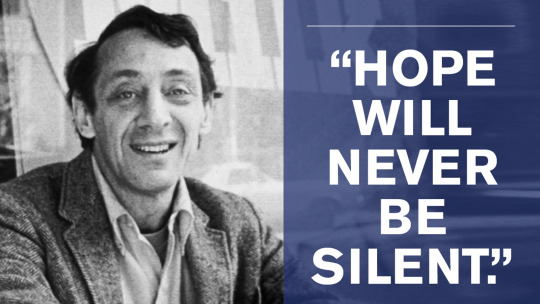
Watching Milk unfold on the screen in front of me has opened my eyes about a lot of things, and being a person who has seen themselves as a neutral party for my those of my friends who are of the LGBTQ community, I find myself trying to find a reason as to why people need to be afraid of difference. I am a minority, a member of the heterosexual norm, so to speak, of a near complete college education. I find that to me; it is neither my sexuality or my skin color that influences my engagement on this topic. It is, the education that I experienced in the real world. I have friends, I have served with men and women, who are members of the LGBTQ community; and it is from those men and women that I have learned my lessons. As a friend to these men and women, equality is starting to play a big factor into my understanding on how society runs and how we a species, are so willing to draw a line in the sand and shun people are on the other side of that line. Critically, looking at the movie, I am some what dismayed that Milk did not take the time to break more barriers at the time. Opening the door on a politically charged topic like equal rights, would have been a great platform on which one could have chosen actors who were of the LGBTQ community to be the cast of characters, creating a stronger foothold for which to spread the word of equality. Despite that, Milk was a great film, the story telling was complied with real new reel footage that was shot during the time of Harvey Milk’s rise and untimely fall, added more of a personal touch to the film, as well as having an actor who bore a similar resemblance to the late Harvey Milk. In the end, consuming Milk opened my eyes to one thing that has been, until recently, and that is “writers seem to continue you balk at the idea that queer characters of color are deserving of dynamic and standalone narratives” (Leiva, 2017). The research and writing that went into developing this film did not leave out any of the characteristics of Jack, portraited by Diego Luna, as Milk’s second lover in the film, who suffered from serious depression, alcoholism and suicidal thoughts. While, Sean Penn delivered an award-winning performance, and being able to humanize the character so that people unfamiliar with the plight of the LGBTQ community and the on-going battle for equality had a better connection to the story and struggle.
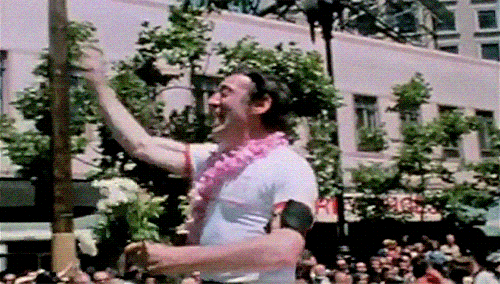
Jr, A. L. M. (2018, August 2). Pose(r): Ryan Murphy, Trans and Queer of Color Labor, and the Politics of Representation. Retrieved from https://lareviewofbooks.org/article/poser-ryan-murphy-trans-queer-color-labor-politics-representation/.
Gross, L. P. (2002). Up from invisibility: lesbians, gay men, and the media in America. New York: Columbia University Press.
Fallon, K. (2018, June 1). 'Pose' Isn't Just Great TV. It's Making Trans History. Retrieved from https://www.thedailybeast.com/pose-isnt-just-great-tv-its-making-trans-history.
Leiva, L. (2017) TV Is Getting More Progressive, But It's Still Failing Queer People Of Color. (n.d.). Retrieved from https://www.bustle.com/p/tv-is-getting-more-progressive-but-its-still-failing-queer-people-of-color-64520.
8 notes
·
View notes
Video
youtube
Liza Minnelli - Mein Herr - Cabaret 1972
Mein Herr
Written by John Kander and Fred Ebb
Sung by Liza Minnelli
Cabaret is a 1972 American musical drama film directed by Bob Fosse, and starring Liza Minnelli, Michael York, and Joel Grey.
Situated in Berlin during the Weimar Republic in 1931, under the presence of the growing Nazi Party, the film is loosely based on the 1966 Broadway musical Cabaret by Kander and Ebb, which was adapted from the novel The Berlin Stories / Goodbye to Berlin (1939) by Christopher Isherwood and the 1951 play I Am a Camera adapted from the same book. Only a few numbers from the stage score were used for the film; Kander and Ebb wrote new ones to replace those that were discarded. In the traditional manner of musical theater, called an "integrated musical", every significant character in the stage version sings to express his or her own emotion and to advance the plot. In the film version, the musical numbers are entirely diegetic, taking place inside the club, with one exception, "Tomorrow Belongs to Me", the only song sung neither by Grey's character of the Kit Kat Klub's Master of Ceremonies nor by Minnelli's character of Sally Bowles. In the sexually charged "Two Ladies", about a ménage à trois, the Master of Ceremonies is joined by two of the Kit Kat girls.
After the box office failure of his film version of Sweet Charity in 1969, Bob Fosse bounced back with Cabaret in 1972, a year that made him the most honored director in the movie business. The film also brought Liza Minnelli, the daughter of Judy Garland and Vincente Minnelli, her own first chance to sing on screen, and she won the Academy Award for Best Actress. With Academy Awards for Best Supporting Actor (Joel Grey), Best Cinematography, Best Art Direction, Best Sound, Best Original Song Score and Adaptation, and Best Film Editing, Cabaret holds the record for most Oscars earned by a film not honored for Best Picture. It is listed as number 367 on Empire’s 500 greatest films of all time.
Cabaret opened to glowing reviews and strong box office, eventually taking in more than $20 million. In addition to its eight Oscars, it won Best Picture citations from the National Board of Review and the Hollywood Foreign Press Association, and took Best Supporting Actor honors for Grey from the National Board of Review, the Hollywood Foreign Press, and the National Society of Film Critics.
https://en.wikipedia.org/wiki/Cabaret...)
Cabaret - Mein Herr (1972)
Subtitled 👇♪ 📽 ♪ 👇
youtube
Liza Minnelli Performing Mein Herr with Chair
youtube
7 notes
·
View notes
Text
George William Crockett, Jr.
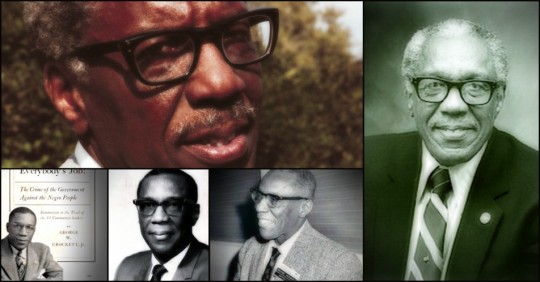



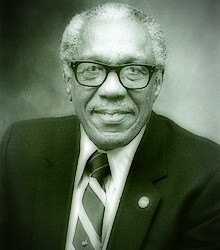

George William Crockett Jr. (August 10, 1909 – September 7, 1997) was an African-American attorney, jurist, and congressman from the U.S. state of Michigan. He also served as a national vice-president of the National Lawyers Guild and co-founded what is believed to be the first racially integrated law firm in the United States.
Early life
George Crockett was born in Jacksonville, Florida to George William Crockett, Sr. (1883–1975) and Minnie Amelia Jenkins (1884–1983), who had two other children: Alzeda Crockett and John Frazier Crockett. George Sr. pastored the Harmony Baptist Church in Jacksonville for more than 30 years and mastered the carpentry trade. George Sr. became a railroad carpenter for the Atlantic Coast Line Railroad. His son, George Jr., would later build room additions and continue practicing carpentry for pleasure in adulthood. Minnie, a gentle woman, Sunday School teacher and poet, said in a November 23, 1969 Times-Union Journal (Jacksonville) article, "My philosophy is that children should be ahead of their parents, should climb a step higher and make a contribution to the family and to society." George Jr. took his mother's philosophy to heart.
Education
Crockett graduated from Stanton High School in Jacksonville. In 1931, he received a Bachelor of Arts degree from Morehouse College, Atlanta, Georgia, a prestigious, historically black university that awarded its first degrees in 1897. He was later given an Honorary LL.D. from Morehouse in 1972, was inducted into Phi Beta Kappa, and served as a Trustee of the College for many years. During his Morehouse tenure, Crockett pledged Kappa Alpha Psi.
Crockett received a law degree from the University of Michigan Law School in 1934 and returned to Jacksonville to practice law that year as one of very few African American attorneys in the state of Florida.
As a lawyer
Crockett participated in the founding convention of the nation's first racially integrated bar association, the National Lawyers Guild in 1937, and later served that organization as its national vice-president.
As the first African-American lawyer in the U.S. Department of Labor, 1939–43, Crockett worked as a senior attorney on employment cases brought under the National Labor Relations Act, a legislative program of President Franklin D. Roosevelt’s New Deal. Crockett also worked as a hearing officer in the Federal Fair Employment Practices Commission during 1943.
That same year the United Auto Workers retained Crockett to run the union’s Fair Practices Committee, which tried to oppose so-called “hate strikes” by white workers, who protested the migration North by Black workers.
In 1946, Crockett along with partners Ernest Goodman, Morton Eden, and Dean A. Robb, co-founded the corporation believed to be the first racially integrated law firm in the U.S., Goodman, Crockett, Eden, and Robb, in Detroit, Michigan. The firm, eventually called Goodman, Eden, Millender and Bedrosian, closed in 1998.
In 1948, Crockett became a member of the legal team that went to New York for the Foley Square trial to defend 11 Communist Party leaders accused of teaching the overthrow of the Federal government, a violation of the Smith Act. Among the 11 were Communist Party leaders: Gil Green, Eugene Dennis, Henry Winston, John Gates, Gus Hall, Robert G. Thompson and fellow Morehouse alumnus and first black New York City Councilman Benjamin J. Davis. In 1949, while defending the Smith Act prosecution, Crockett and four other defense attorneys were sentenced by Judge Harold Medina to Federal prison for contempt of court. Crockett served four months in an Ashland, Kentucky Federal prison in 1952. A portion of Crockett's jury summation at the trial was published in "Freedom is Everybody's Job!: The Crime of the Government Against the Negro People, Summation in the trial of the 11 Communist leaders."
Crockett’s criticism of McCarthyism and the House Un-American Activities Committee grew after that case, and in 1952 he represented future Detroit mayor Coleman Young and the Rev. Charles A. Hill before the Committee.
As large numbers of young civil rights volunteers traveled to the U.S. South in the spring of 1964, Crockett recruited lawyers from the National Lawyers Guild to follow them. He founded the National Lawyers Guild’s office in Jackson, Mississippi, and managed the Mississippi Project (a coalition of the NLG and other leading civil rights legal organizations) during the 1964 Freedom Summer.
The infamous murders of the civil rights workers James Chaney, Andrew Goodman, and Michael Schwerner occurred in June of that year. The three had been arrested by local police while investigating the arson of a Black church near Philadelphia, Mississippi. Collaborating with local white supremacist vigilantes, the Neshoba County sheriff released the three men from jail late at night, and other civil rights workers reported their disappearance.
From the NLG office in Jackson, Crockett dispatched Guild lawyers to search for the missing men. The effort was in vain, and, years later, Crockett described his growing despair in the 1995 PBS documentary Mississippi America, narrated by Ossie Davis and Ruby Dee.
In the film, Crockett recounts his drive from Jackson to Meridian in a personal search for the missing men. He survived an effort of the sheriff to arrange his ambush by loudly offering driving directions, while white supremacists loitered nearby. Crockett returned safely to Jackson. He offered a full report to the Justice Department and the FBI, who refused to take the information. The murdered bodies of the 3 young men, one black, two white, were found days later.
As a judge
In 1965, Crockett became a candidate for the Detroit Common Council. Bob Millender guided his campaign. Crockett lost by a small margin "after he had been severely red-baited in the election," according to his former law partner Ernie Goodman (A Tribute to George W. Crockett, Jr, privately published, 1997.)
In 1966, Crockett was elected Judge of Recorder's Court, Wayne County, Michigan. The court handled criminal cases. From that bench, Judge Crockett incurred the wrath of the white corporate media and endured death threats for his role in a highly publicized police shooting, raid, and mass arrest.
On March 29, 1969, following an officer-involved shooting outside New Bethel Baptist Church in which a Detroit police officer died, police officers fired into and stormed the church. A secessionist organization, the Republic of New Afrika, had rented the church for a meeting. Witnesses in the majority African-American neighborhood later stated that the responding officers had all been white. More than one-hundred fifty persons, including juveniles, were arrested inside the church and taken to police headquarters. The church pastor called Judge Crockett before dawn.
Crockett opened temporary court at police headquarters. In refusing to find probable cause to hold the people from what he termed a “collective punishment” mass arrest, Judge Crockett released 130 of the arrested persons. In the controversy that followed, Detroit saw the appearance of bumper stickers that read, “Sock It to Crockett” and "Impeach Judge Crockett". The police association organized a picket line at the courthouse. The black community and interracial civic organizations supported Crockett.
In 1974, Crockett was elected Chief Judge of the Detroit's Recorder's Court. He served there until retiring in 1978.
As a Congressman
In November 1980, as the candidate of the Democratic Party from Michigan's 13th congressional district, Crockett was elected in a special election to the 96th Congress to fill the vacancy caused by the resignation of Charles C. Diggs, Jr. from the U.S. House of Representatives. Dennis W. Archer ran Crockett's successful election [1] campaign].
Crockett was simultaneously elected to a full term in the 97th Congress and was subsequently re-elected to the next four Congresses, serving from November 4, 1980, to January 3, 1991. Speaker of the House Thomas "Tip" O'Neill swore in 71-year-old Crockett in the presence of Crockett's wife Dr. Harriette Clark Crockett, son, and 96-year-old mother, Mrs. Minnie Crockett. She recited a poem she composed many years earlier titled, Our Children Three.
During his tenure, Crockett was a member of the Congressional Black Caucus, the Democratic Study Group, the Congressional Caucus on Women's Issues, and the Congressional Arts Caucus. He also served on the House Judiciary Committee, the Select Committee on Aging, and the House Foreign Affairs Committee. As a member of the Africa Subcommittee, Crocket authored the Mandela Freedom Resolution, HB.430, which called upon the South Africa government to release Nelson Mandela and his wife Winnie Mandela from imprisonment and banning. The resolution was passed by both houses of Congress in 1984. Later, Crockett continued to denounce apartheid in South Africa and was jailed with Detroit Mayor Coleman A. Young and others for demonstrating in Washington, DC against apartheid.
Crockett filed suit against the Reagan administration claiming violation of the War Powers Act in providing El Salvador with military aid (Crockett v. Reagan, 720 F.2d 1355 (C.A.D.C., 1983)).
Crockett chaired the Foreign Affairs' Subcommittee on Western Hemisphere Affairs from 1987 until his retirement.
On Wednesday, March 28, 1990 Crockett, who was affectionately called "Judge" by his House colleagues, announced on the House Floor: "Mr. Speaker, a few days ago the press carried the story on the death of the Honorable Harold Medina, who was the judge who presided over the famous communist trials in New York back in 1949 and 1950. In the course of that trial, Judge Medina sentenced the five defense lawyers to prison. I'm the only living survivor of those five defense lawyers.
"During the four months that I served in a federal prison, it never occurred to me that one day I would also serve in the United States Congress and be a member of the committee having oversight jurisdiction over all federal judges and all federal prisons.
"Today, Mr. Speaker, I rise to inform my colleagues that I have decided to retire from the House at the conclusion of the 101st Congress. After 68 years of working, championing unpopular causes, I'm hoping to enjoy a little time off.... I've been privileged to serve the people of Michigan's 13th District in this body, and it has been a challenge and an honor I will always cherish."
Representative John Conyers, also from Detroit, described Crockett's announcement by saying "When he finished, all the members stood and clapped." Source: Detroit Free Press, March 29, 1990, p. 15A.
Family
George and Ethelene Crockett had three children: Elizabeth Crockett Hicks, George W. Crockett III, and Dr. Ethelene Crockett Jones. George III also served on the Recorders Court. George Jr. had nine grandchildren: Wayne, Charles, Kyra, Iyisa, Kimberly, Kelly, LeBeau and Enrique, and eight great-grandchildren. One nephew, Rear Admiral Benjamin Thurman Hacker (1935–2003) was a U.S. Navy officer, who became the first Naval Flight Officer to achieve Flag rank.
Following the death of Dr. Ethelene Crockett, George Crockett Jr. married Dr. Harriette Clark Chambliss, a pediatrician in Washington, D.C.
Crockett is buried in Laurel, Delaware in the New Zion United Methodist Church cemetery, with his parents and other generations of Crocketts and within walking distance from Crockett Street, named in honor of the Crockett family.
http://wikipedia.thetimetube.com/?lang=en&q=George%20W.%20Crockett%2C%20Jr.
6 notes
·
View notes
Photo
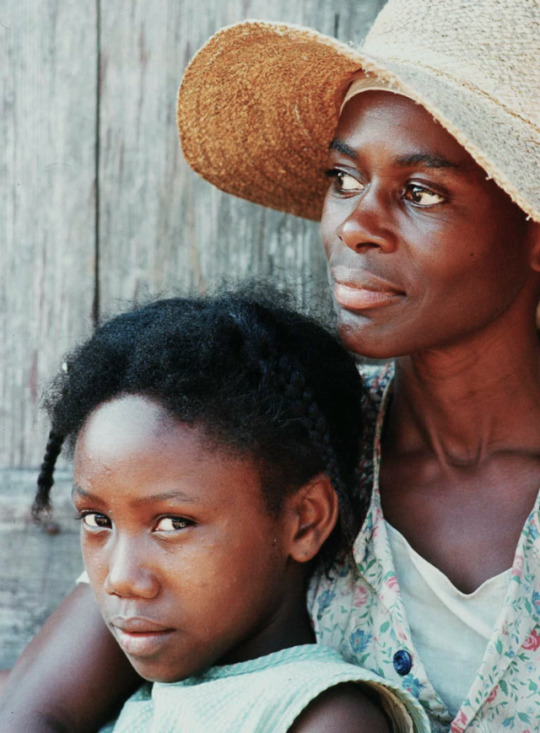
Black History month: Goddesses of Color
Cicely Tyson as Depression-era sharecropping mother Rebecca Morgan in the tender family drama Sounder (1972, Martin Ritt; with Yvonne Jarrell), for which she received Oscar and Golden Globe nominations and the Best Actress award from the National Society of Film Critics. Here are Tyson’s own views on the legacy of black female representation in cinema:
“The story in Sounder is a part of our history, a testimony to the strength of humankind. Our whole black heritage is that of struggle, pride and dignity. The black woman has never been shown on the screen this way before. She has always been a prostitute, a drug user or someone who slept around. She has never been given any dignity at all... [The black woman] was the strength of the black race for hundreds of years. But there has never been a positive image of her... of a full home life with both mother and father figures, and with warmth, beauty, love and understanding. We do have that. It does exist.” — New York Times (October 1972)
#Cicely Tyson#Sounder#Black History#70s#African American#women of color#Oscar nominee#actress#black#motherhood#race#black cinema#coming of age#family film#interviews
133 notes
·
View notes
Text
NOSFERATU on The Schlocky Horror Picture Show
July 27, 2008
OPENING: Hello, good evening, and welcome to the Schlocky Horror Picture Show. I'm your host, Nigel Honeybone. Back in the 1920s, German director F.W. Murnau was so impressed with Bram Stoker's novel Dracula, he made Nosferatu: A Symphony Of Horror, which remains one of the greatest horror films of all time.
The trouble is Murnau didn't have permission, so he simply changed the character names and locales in the script. Harker became Hutter, Dracula became Orlok, England 1890 became Germany 1830, etc.
But when the film was translated for English-speaking audiences, the powers-that-be chose to use Bram Stoker's original familiar character names, but in the process a few typos occurred, for instance Mina Harker becomes Ellen Hutter becomes Nina Harker, understand? I don't...
Like so many silent films, the images may be Public Domain, but the soundtrack remains copyright protected. So to accompany us on this Symphony Of Horror we have the nerve-jangling sounds of local composer Jeremy Newton, ably assisted by Nat Scott-Quinell. Ladies, Gentlemen and Creatures Of The Night, I am extremely proud, for a change, to present the enigmatic Max Schreck as the grand daddy of all vampires in FW Murnau's original Nosferatu...
BREAK: Watch the embodiment of evil spread plague across the land, then after the ads we can get back to the chilling Nosferatu on the Schlocky Horror Picture Show.
MIDDLE: Hello, and welcome back to The Schlocky Horror Picture Show. Nosferatu! The name itself is enough to induce an excrement hemorrhage in anyone who watched this movie during their youth, like I did. I mean, those fingernails! He clearly isn't getting regular manicures. Brrrrr! And Nosferatu had the shaved-head look long before it was trendy. Overall, it's one fine piece of cinema.
Contrary to popular opinion, the word Nosferatu does not mean Vampire, Undead, or anything else like that. The term originally came from the old Slavonic word "nosufur-atu", which itself was derived from the Greek Nosophoros. Nosophoros, in the original Greek, stands for Plague Carrier. This derivation makes sense when one considers that amongst western European nations, vampires were regarded as the carriers of many diseases, such as sexually transmitted diseases, TB, and reality television.
The full title is "Nosferatu, eine Symphonie des Grauens." As you've no doubt surmised, Nosferatu was directed by a German. In this case it's Friedrich Wilhelm Murnau, one of the "Big Three" Weimar republic filmmakers along with Fritz Lang and G.W. Pabst. Murnau's work often appears on critic's best film lists and he's cited as an influence by filmmakers to this day, yet there seems to be little that gives his work and career the notice it deserves. Not surprising, considering his yet to be fashionable lifestyle choices and somewhat suspicious death in a car accident in 1931.
The film stars the aptly named Max Shreck as the vampire. Schreck, in case you weren't aware of it, is the German word meaning "fear". How cool is that? Schreck was a Stanislovsky method actor, which meant that he immersed himself fully in the character...as well as the unconsecrated soil of Transylvania. He was so effective that some on the set of Nosferatu believed that Shreck might actually be a vampire. This conceit was later used in "Shadow of the Vampire", a 2000 release starring John Malkovich as Murnau and Willem Dafoe as Max Shreck, a vampire pretending to be an actor.
What's interesting is how the world almost lost the chance to see Nosferatu at all. Unfortunately for production company Prana Films, this unlicensed adaptation of Dracula was too thinly veiled, and Florence Stoker, widow of the late Bram Stoker, sued with the help of lawyers from the British Incorporated Society of Authors.
However, Stoker and the BISA weren't the only people pursuing Prana-Films: Prana was a sinking ship running aground on a financial reef. Just as the BISA sued Prana, it went into receivership and all materials and debts were taken over by the Deutsch-Amerikansch Film Union. The BISA then pursued the Film
Union and demanded that all copies of Nosferatu be surrendered. In July 1925, the issue was settled and all known copies of Nosferatu were handed over to Stoker, and destroyed.
Or so Stoker thought. In October of that year, the Film Society in England asked her to endorse a classic film festival, and first on the list was the infamous Nosferatu. Stoker was furious and demanded that the Society give her their copy, but the Film Society refused and legalities followed. By 1928 Universal Pictures owned the screen rights for Dracula, and therefore all adaptations of it, including Nosferatu. Initially, Universal allowed the Film Society to keep the print, but after pressure from Florence Stoker they acquired the print, and it joined its departed kin in 1929. Then came a sudden spurt of American copies of the film under the name Nosferatu the Vampire, but Universal had them all destroyed in 1930. It finally seemed as though this pesky film had met its end.
This was not the case though. Following Florence Stoker's death in 1937, copies of the film started cropping up again, as if the celluloid itself was among the immortal undead.
Nosferatu truly regained its popularity in 1960 due to American television screenings, and in 1972 Blackhawk Films released the uncut original to the collector's market as Nosferatu the Vampire, which brings us up today. Now, due to it's availability via the Public Domain, it's damn near impossible to find a DVD horror collection that doesn't have a copy of Nosferatu!
But only our version has a brand spanking new soundtrack by Sydney composer Jeremy Newton, who we now cross to almost "live" via satellite. Welcome to the show, Mr. Newton...
Jeremy: Good evening.
Nigel: Jeremy... you don't mind if I call you Jeremy?
Jeremy: No, not at all.
Nigel: I'm sorry, Mr, Newton, that's all we have time for tonight. As you know, these live satellite crosses cost quite a bit more than community TV can afford...
Jeremy: I'm only in Marrickville!
Nigel: So without any further ado, let's get straight back to tonight's special presentation of the original 1922 silent classic Nosferatu.
CLOSING: After almost a century, the original Nosferatu is a film that has eventually grown on me. Its frank gruesome quality is a stark contrast to the scratchy clean horror of Universal's horror films of the 1930's and 1940's, and the completely unromantic treatment of the Count fits well with modern cynicism. Max Schreck's Orlok is one of the most familiar images in film history, or for that matter in the history of images.
So please join me next week on The Schlocky Horror Picture Show when I have the opportunity of inflicting a pain beyond pain, an agony so intense it shocks the mind into instant mashed potato! Toodles!
by Lushscreamqueen
0 notes